Accretion and outflow


SU Aur
synthetic image
Credit: Christian Granzow Holm

Michael Küffmeier
Carlsberg Reintegration Fellow at Niels Bohr Institute
Stars accrete

Manara et al. 2023
What is essential for accretion?
Angular momentum transport!
The classical picture
credit: M. Persson
star formation
planet formation

Viscous accretion disk model
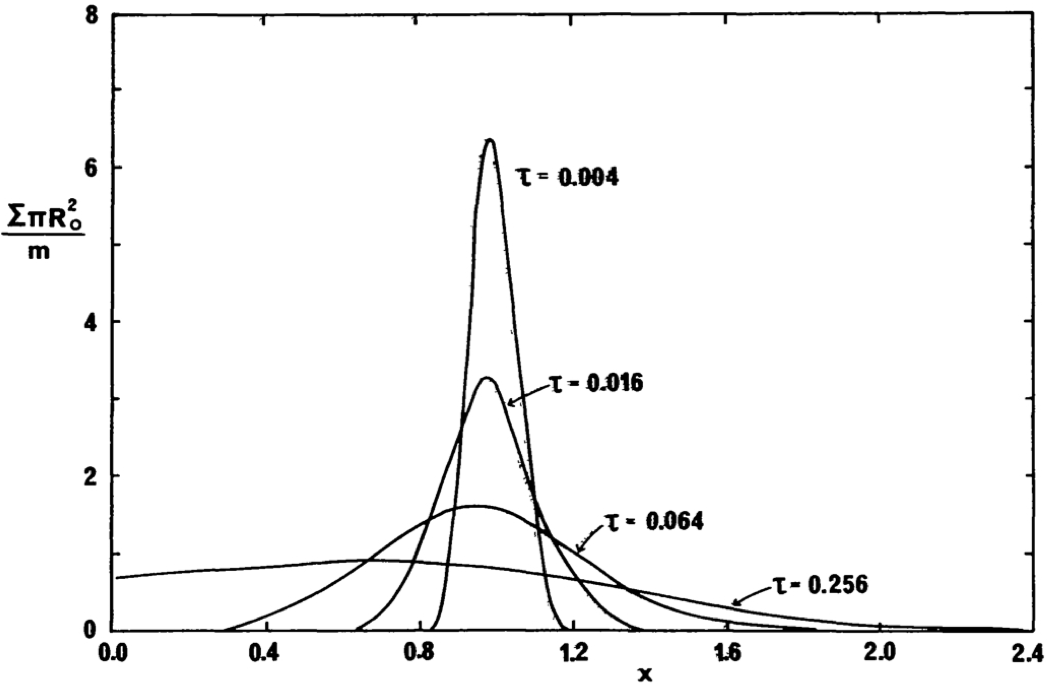
Spreading of a disk ring
Pringle 1981

.
.
Image: G. Lesur
recall Joanna Drążkowska's lecture
Viscous accretion disk model
Molecular viscosity
>10 million times too long compared to disk lifetime!

.

Polnitzky et al. 2025 in prep
Viscous accretion disk model
turbulent transport
sound speed
scale height
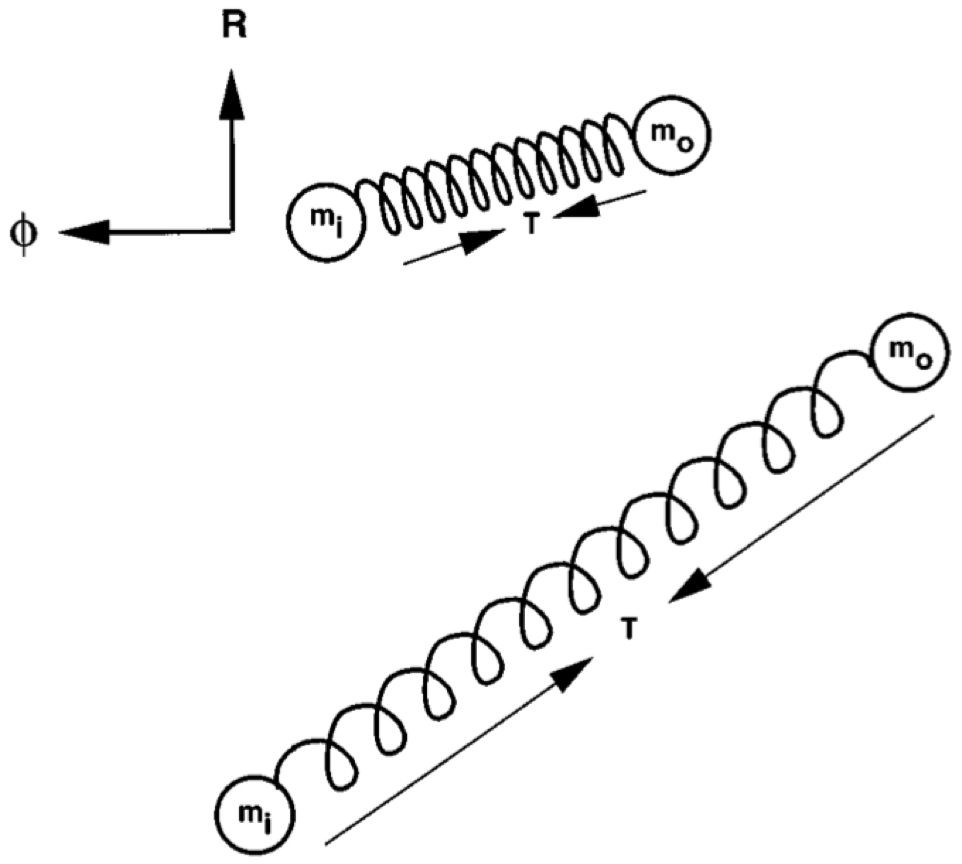
magnetorotational instability (MRI)

.

Polnitzky et al. 2025 in prep
Velikhov '59, Balbus & Hawley '91
Shakura & Sunyaev '73; Lynden-Bell & Pringle '74
Viscous accretion disk model
turbulent transport
sound speed
scale height
magnetorotational instability (MRI)

.

Are disks MRI active?
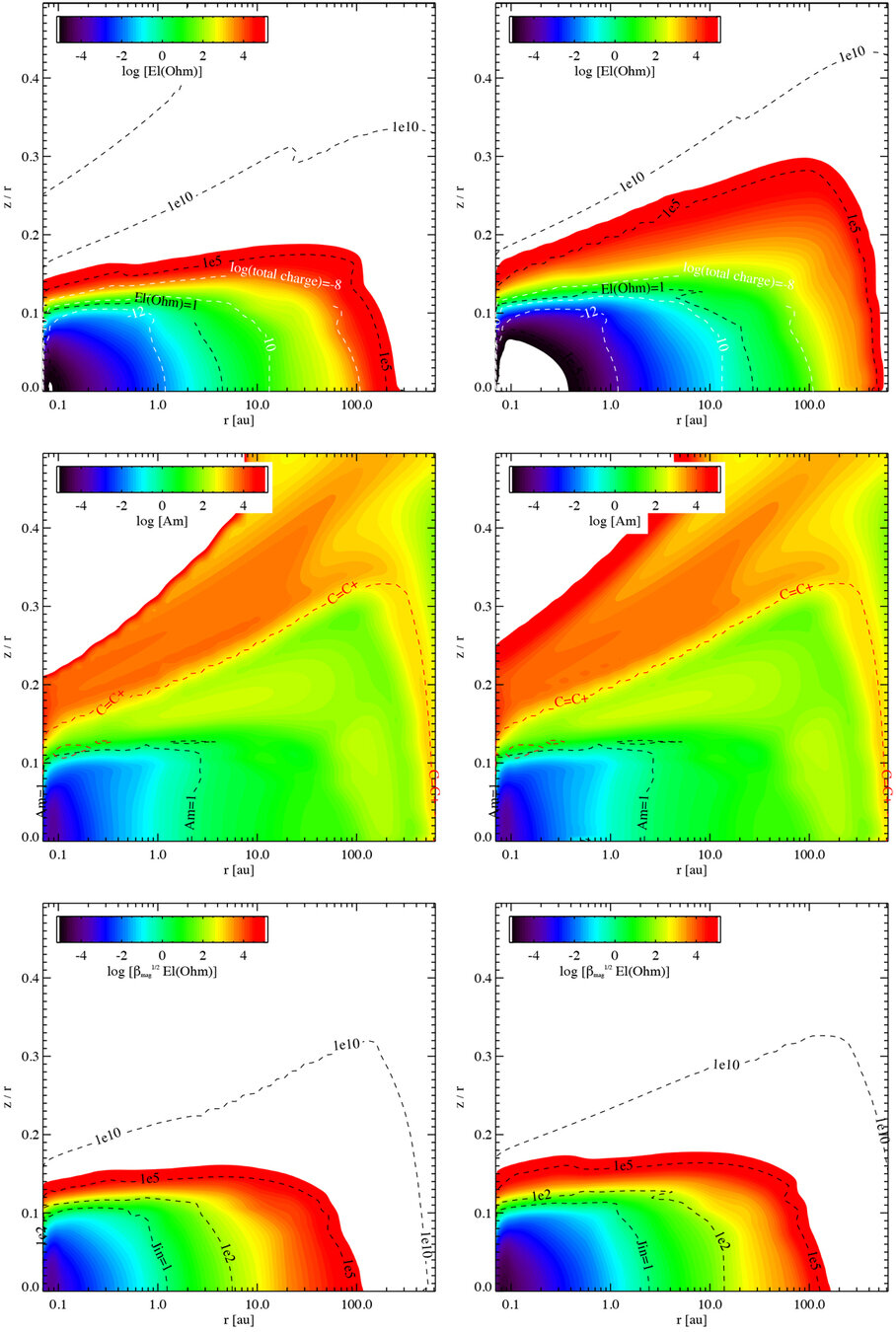
Thie et al. '18
MRI is (mostly) suppressed
Perez-Becker & Chiang '11

Other instabilities possible, but do observations match values?
Observations:
Pinte et al. '23 (and references therein)
Challenging.
Viscous accretion disk model
turbulent transport
sound speed
scale height

.

Other instabilities possible, but do observations match values?
Observations:
Pinte et al. '23 (and references therein)
Challenging.
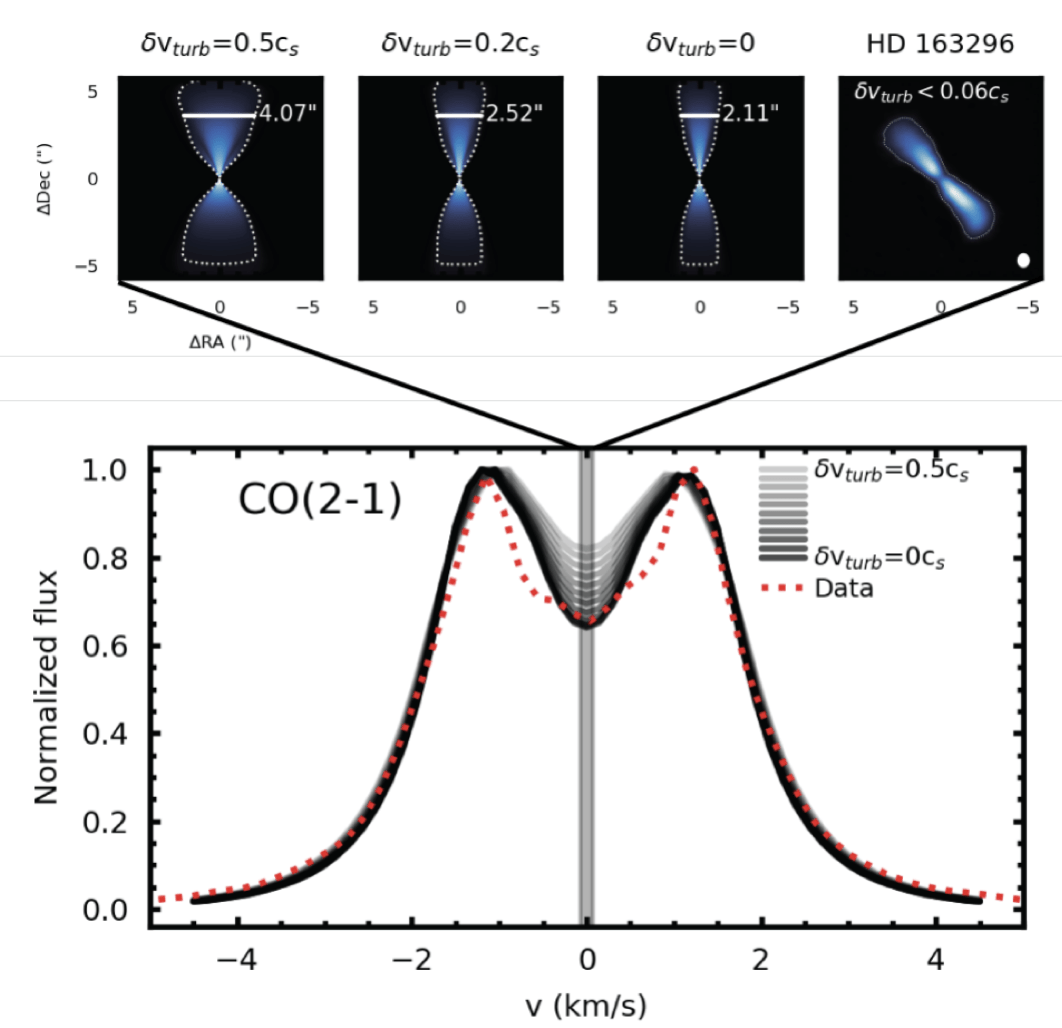
Flaherty et al. '15
Disk

Are we missing anything?

are
Material can be ejected through winds
Option 1: Photoevaporative wind ( )
fully ionized gas
neutral gas
molecular gas
Outflows!
outflows
see posters Aru and Gkimisi; review Pascucci et al. '23
Disk outflows

Are we missing anything?

are
Material can be ejected through winds
Option 2: Magnetically driven jet/wind ( )

are
Outflows!
Machida et al. 2016
image: Armitage '18

Are we missing anything?


are
Outflows!
Machida et al. 2016
Disk outflows
image: Armitage '18
Are we missing anything?

are
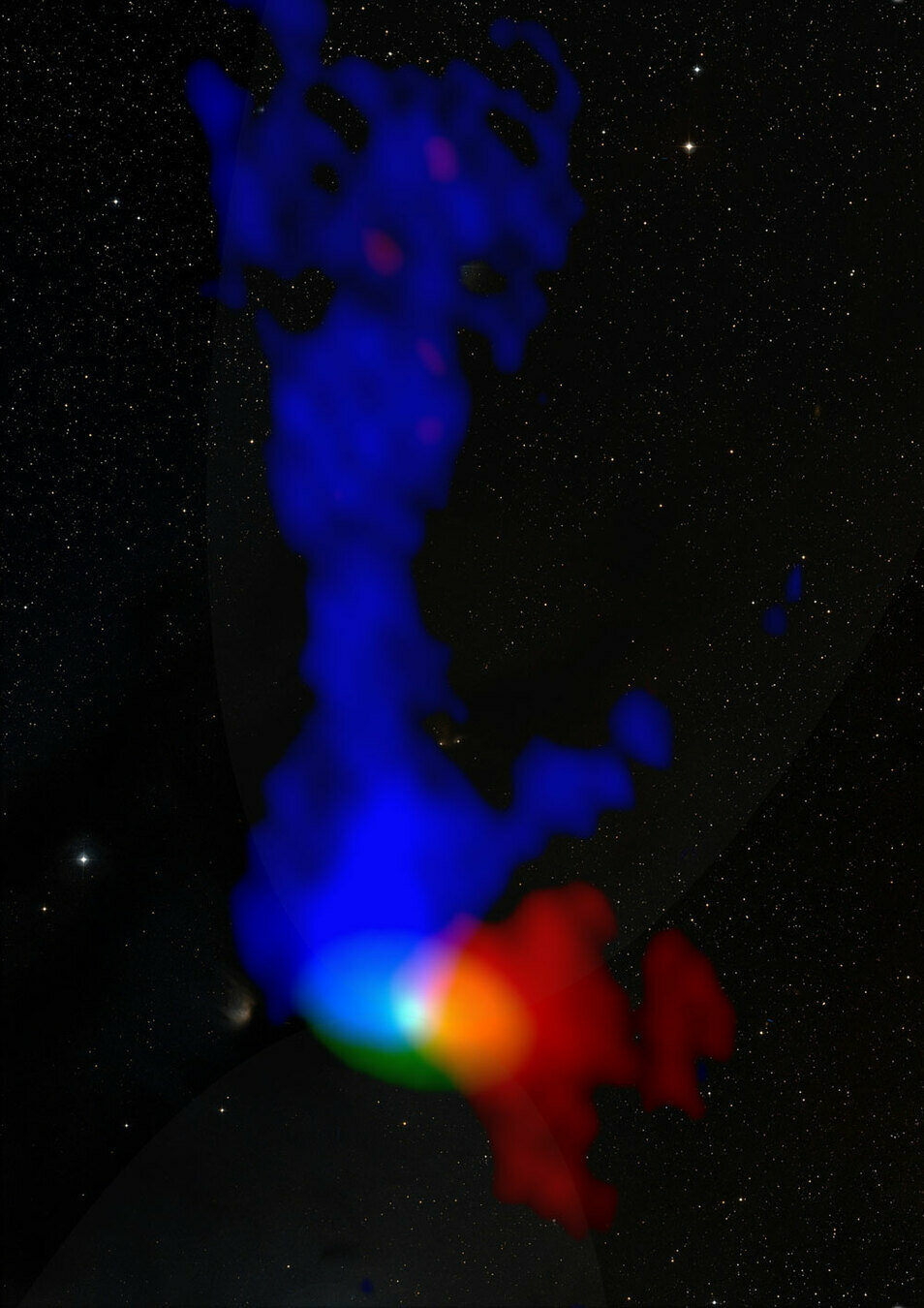
Outflows!
Bjerkeli et al. 2016
Machida et al. 2016
Disk outflows
Magnetocentrifugal wind
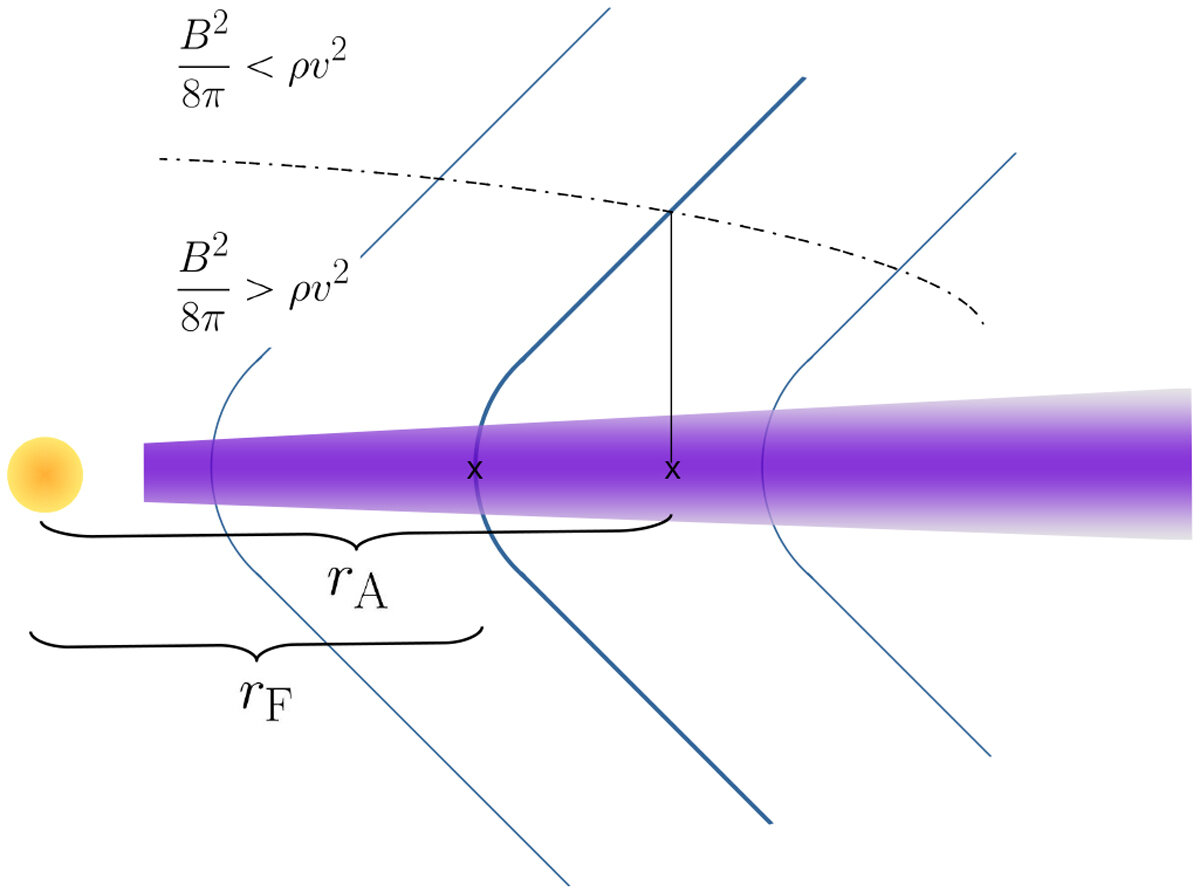
Credit: Kimmig et al. '20
for a thorough explanation of magnetocentrifugal wind see Spruit '96
Blandford & Payne '82
Magnetocentrifugal wind

for a thorough explanation of magnetocentrifugal wind see Spruit '96
Blandford & Payne '82
efficient possibility of transporting angular momentum if
accretion
wind
Alfvén
e.g.
(accounting for bipolar outflow)
Credit: Kimmig et al. '20
Magnetothermal wind
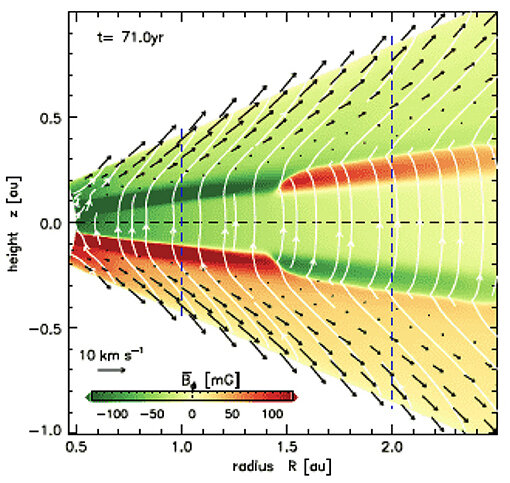
Gressel et al. '15
Combination of magnetic and thermal wind appears most realistic
Bai '17, Béthune et al. '17, Wang et al. '19, Gressel et. '20, Rodenkirch et al. '20, Lesur et al. '23 (PPVII)
Magnetised outflows
Credit: Christian Granzow Holm

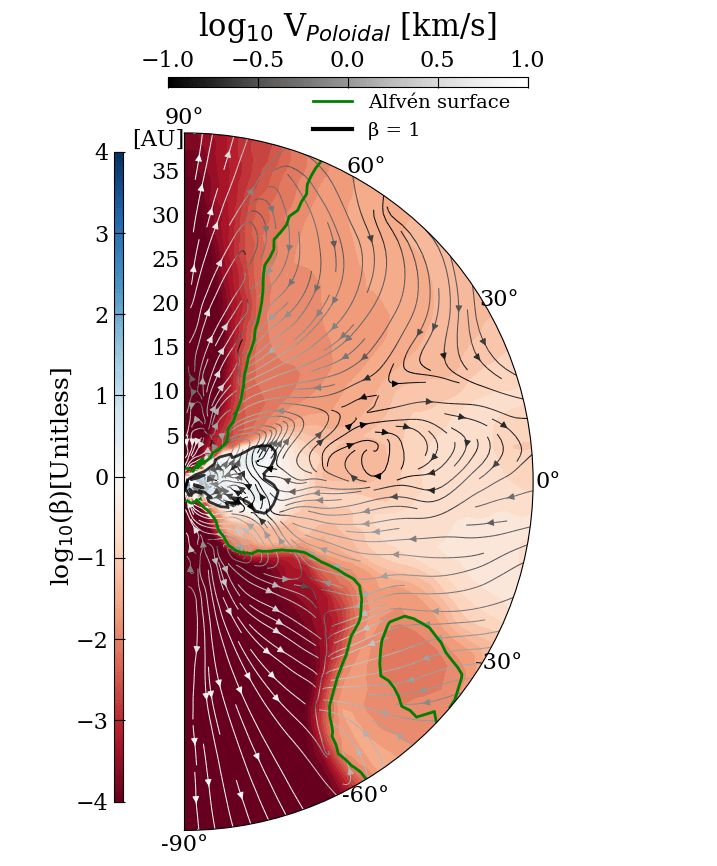

Credit: Kimmig et al. '20
Dust polarization to measure magnetic fields
Polarization depends on degree of grain alignment and elongation
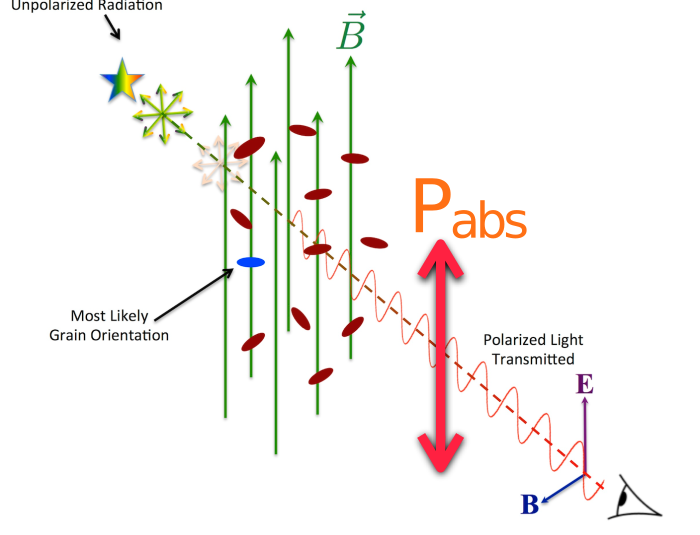
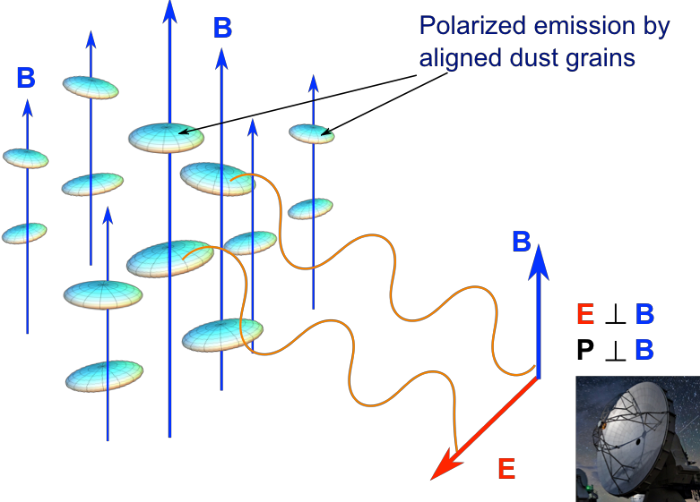
Credit: B. G. Anderson
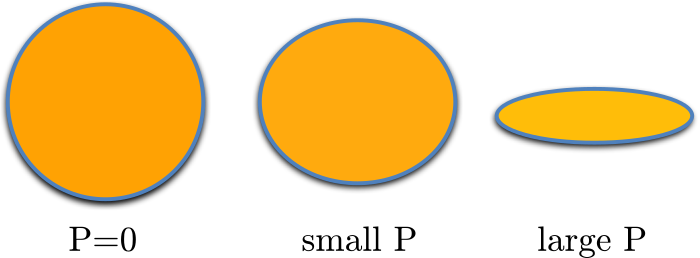
Measuring linear polarization of dust grains allows to determine magnetic field orientation ...
... if you know the origin of polarization.
unfortunately polarization in disks is often dominated by scattered light (see Guidi's lecture on Friday).
Dust polarization to measure magnetic fields
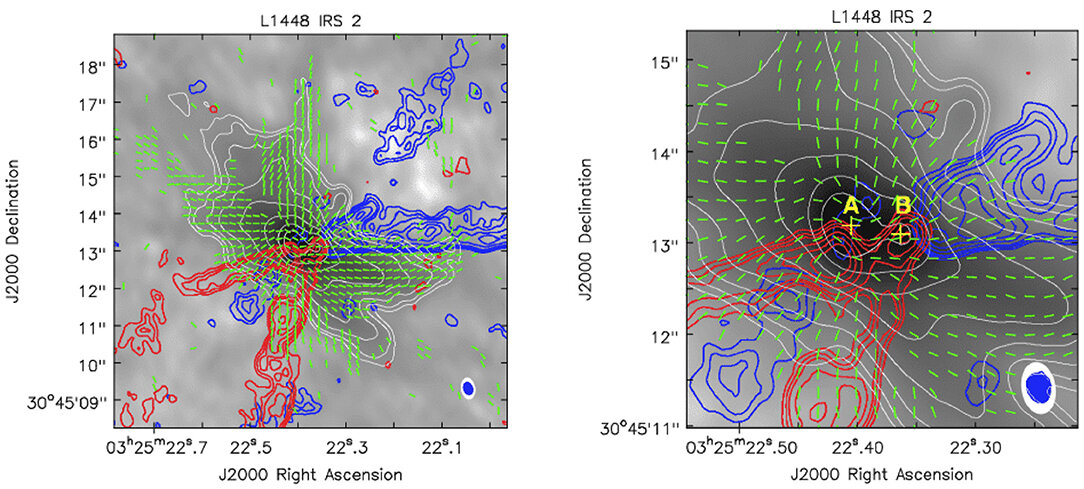
Credit: Kwon et al. 2019
Polarization traces magnetic field
Küffmeier, Reißl et al. 2020
Emitted radiation
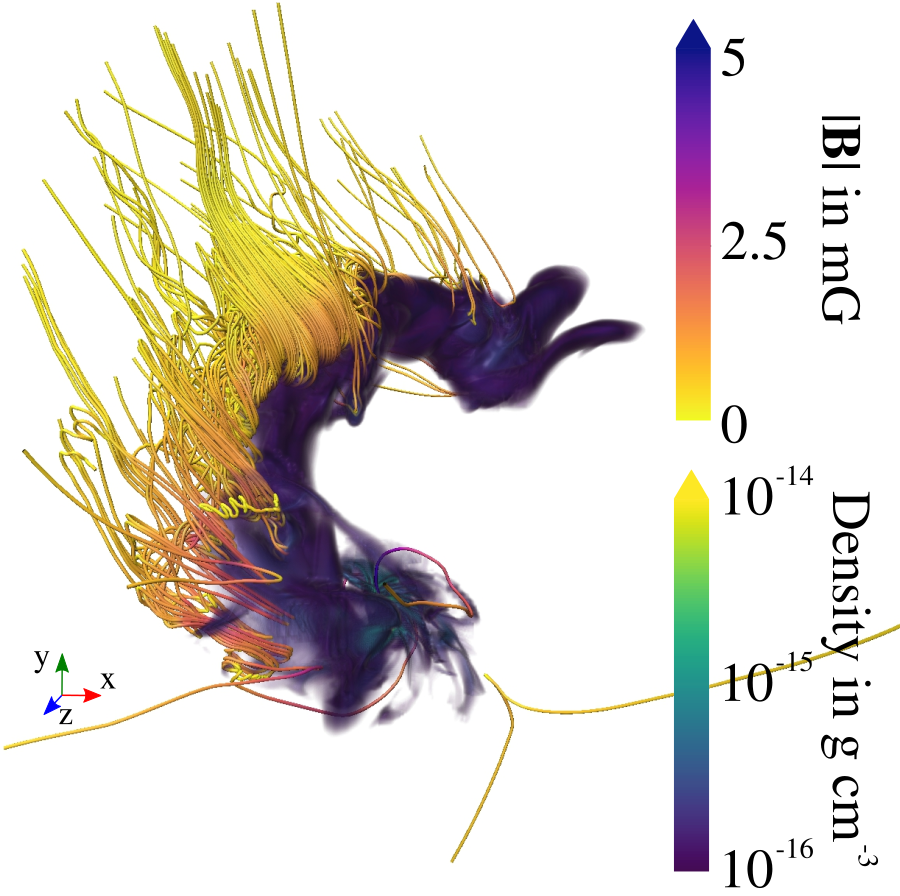
synthetic observations
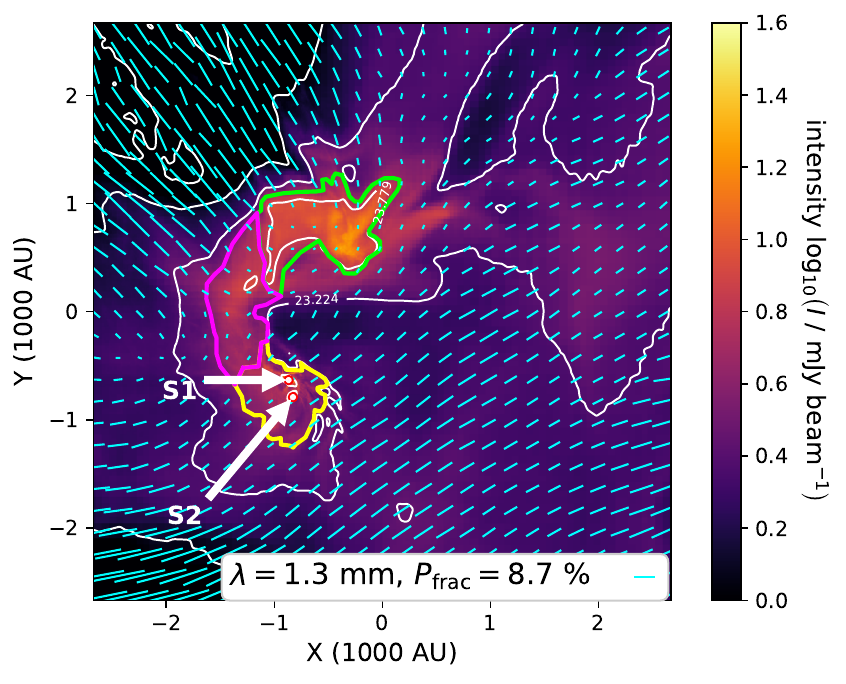
(we display e-vectors rotated by 90°)
Polarization traces magnetic field
Küffmeier, Reißl et al. 2020
Emitted radiation

synthetic observations

(we display e-vectors rotated by 90°)

B
Synthetic dust polarization maps at 1.3 mm
Küffmeier, Reißl et al. 2020

Emitted radiation
Polarization fraction in bridge:
a few %
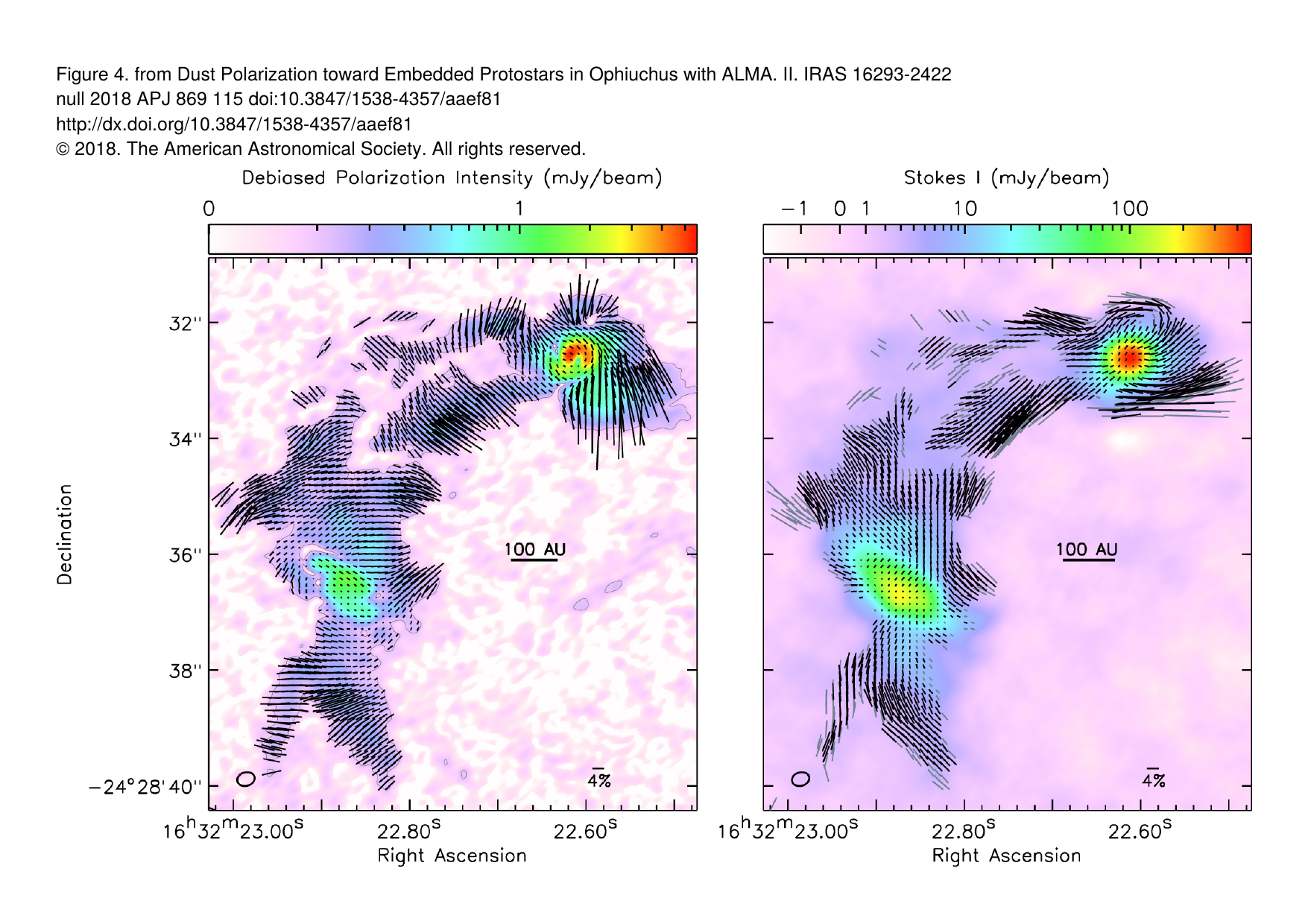
Polarization fraction in bridge:
up to 20 %
IRAS 16293--2422
Sadavoy et al. 2018
alignment efficiency higher than efficiency produced by standard RAT alignment
(also Le Goeullec+20)
IRAS 16293-2422 highly magnetized?
Reason for wavelength dependence
Küffmeier, Reißl et al. 2020
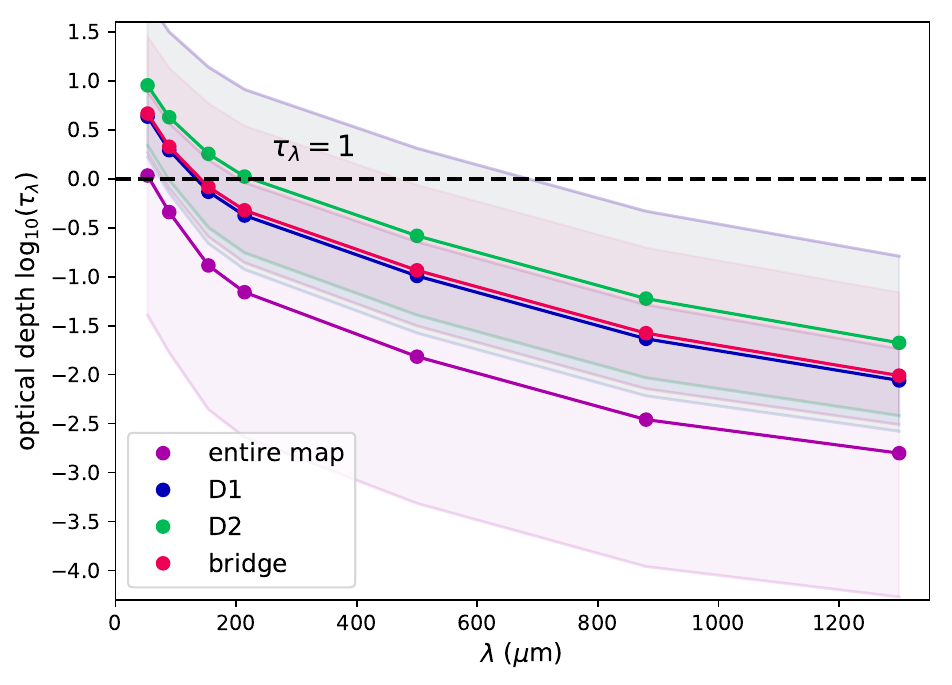
Dichroic extinction
Take-away for scales beyond the disk
< 200 micron: dichroic extinction; challenging to trace B reliably
> 200 micron: thermal emission; linear polarization traces B

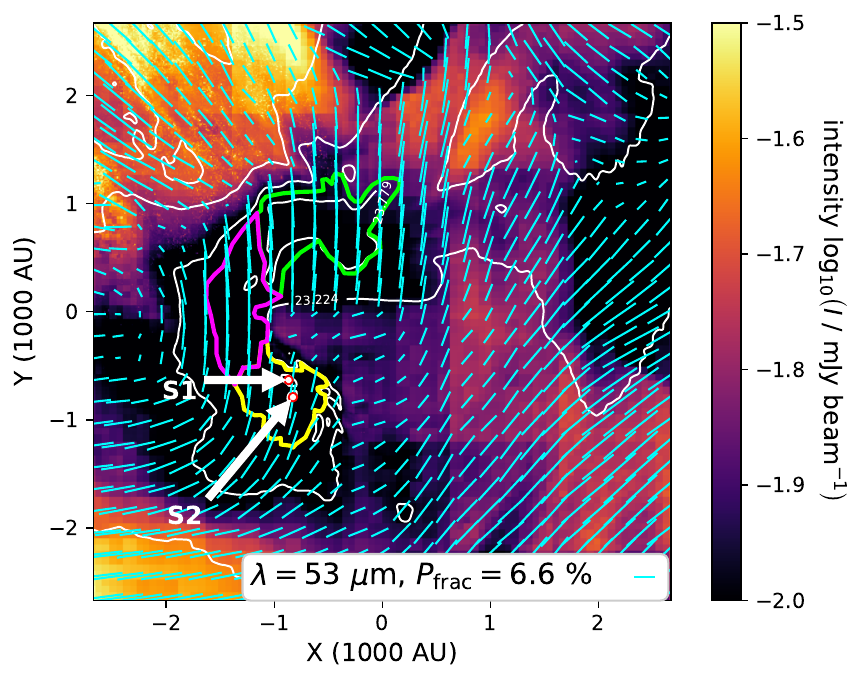
(see also Valdivia et al. 2022)
see also Reissl et al. 2014, 2016 for more discussion of the flip
Credit: Tsukamoto et al. 2021
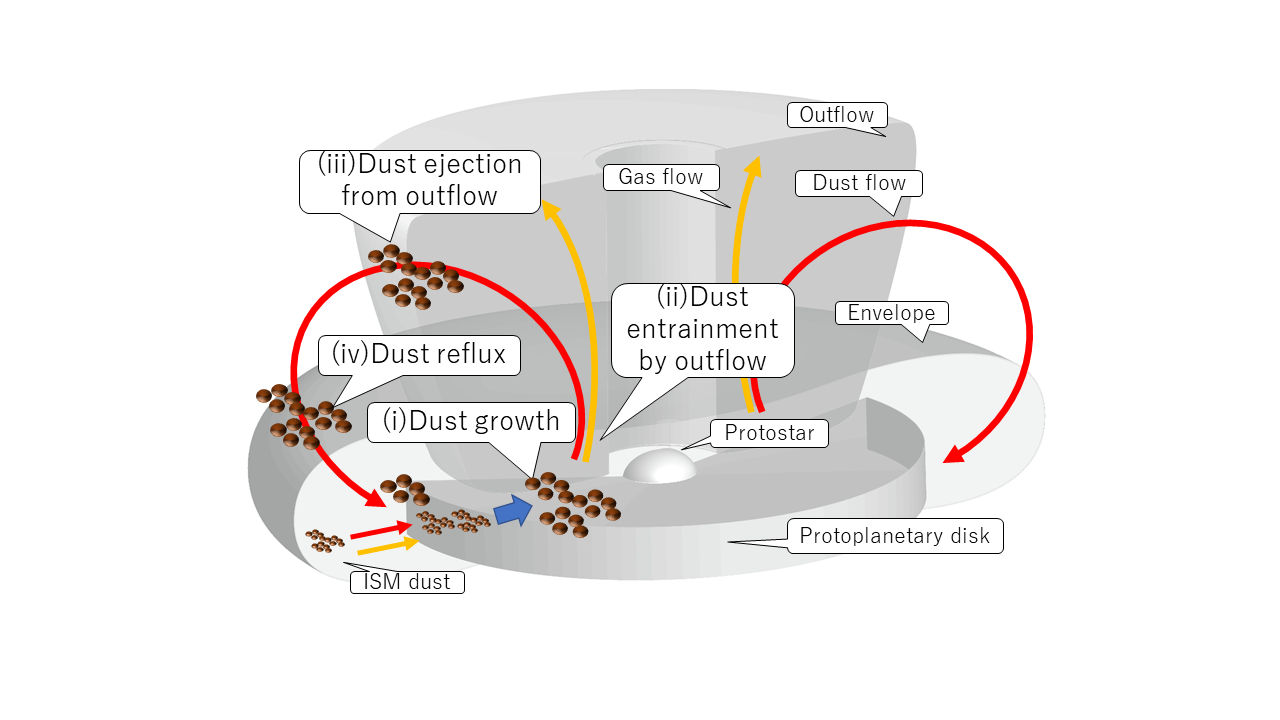
"Ash-fall" scenario aka conveyor belt
Possibility of lifting CAIs and/or chondrules from inner disk to outer disk

Credit: Connelley et al. 2012
Viscous vs wind-driven disk


wind-driven disk
Images: G. Lesur
viscous accretion disk
- purely radial transport of angular momentum
- disk turbulence leads to enhanced transport in disk
- "Classical" disk model
Shakura & Sunyaev '73; Lynden-Bell & Pringle '74
turbulent transport
sound speed
thickness of half disk
- vertical transport of angular momentum
- magnetic fields exert torque which allows accretion
- large-scale magnetic field model
Blandford & Payne '82
efforts in formulating analytic prescription for wind scenario (Tabone et al. 2022)
Viscous vs wind-driven disk
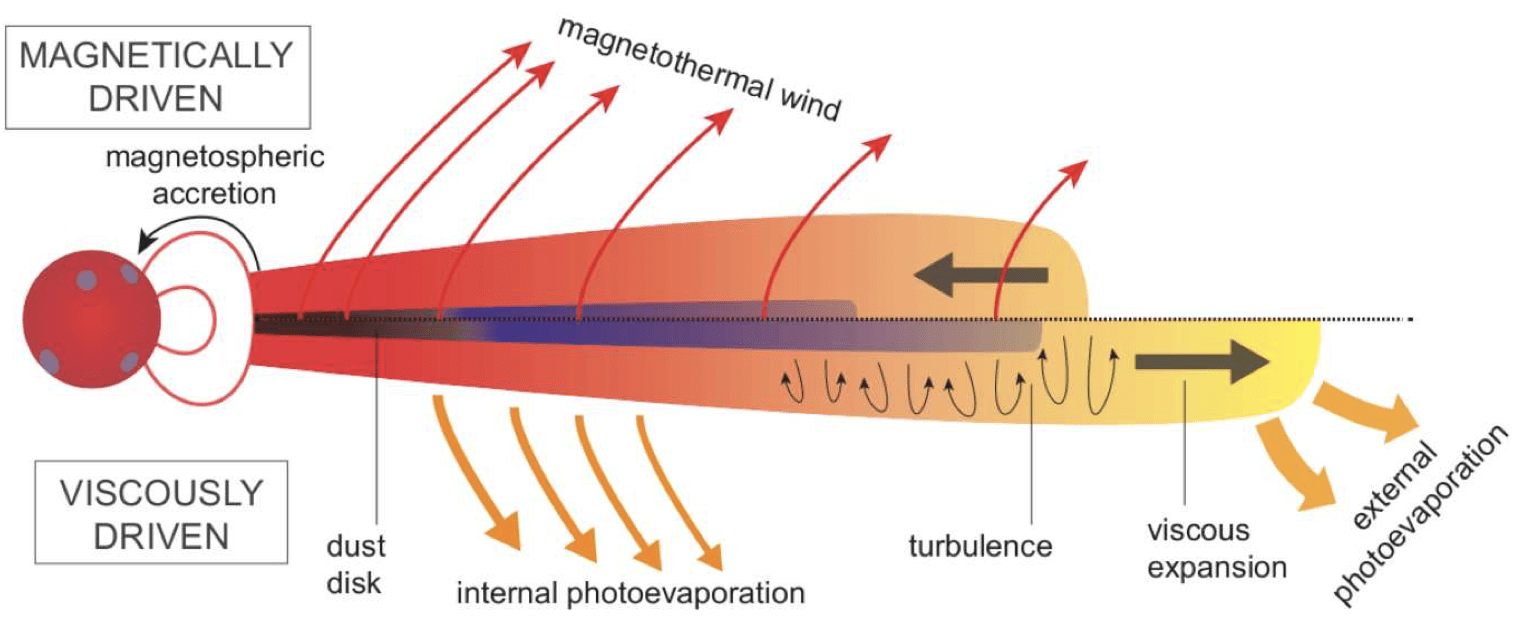
Manara et al. 2023
Spreading vs wind-driven?
Manara et al. 2023
Interpreting disk sizes as outcome of either viscous spreading or MHD wind

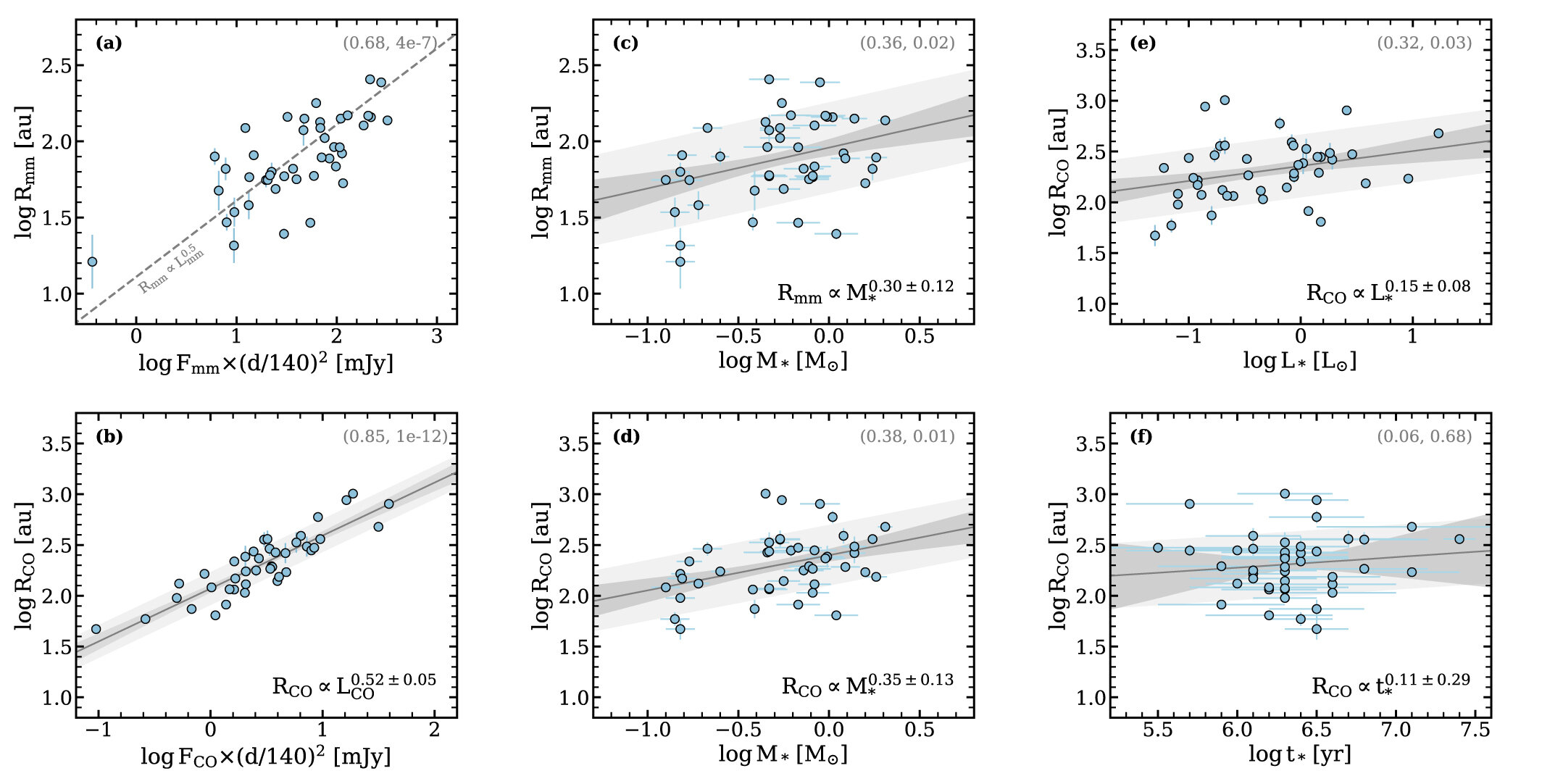
Long et al. 2022
?
magnetohydrodynamics
Disk size can shrink in viscous model when accounting for external photoevaporation
e.g. Haworth & Winter 2023
Rosotti et al. '19, Somigliana et al. '23, Tabone et al. '22, Trapman et al. '22, Zagaria et al. '22
Evolved steady disk overview

Credit: Armitage 2018
poster by Fullana-García
Preliminary take-aways
- Accretion requires angular momentum transport
- Angular momentum can be transported radially through turbulent viscosity ( -parameter) or through magnetically driven winds
- Ongoing paradigm shift in interpreting accretion disks as predominantly outflow-driven rather than viscous accretion disks (see PPVII reviews by Lesur et al., Pascucci et al.)

Outflows are ubiquitous
...but wait a second!


The classical picture
credit: M. Persson
star formation
planet formation

History of modeling disk formation
spherical core collapse:
rotation
magnetization (mass-to-flux ratio)
non-ideal MHD effects
dust evolution
turbulence
useful for parameter studies
Bonnor-Ebert sphere
or uniform density
History of modeling disk formation

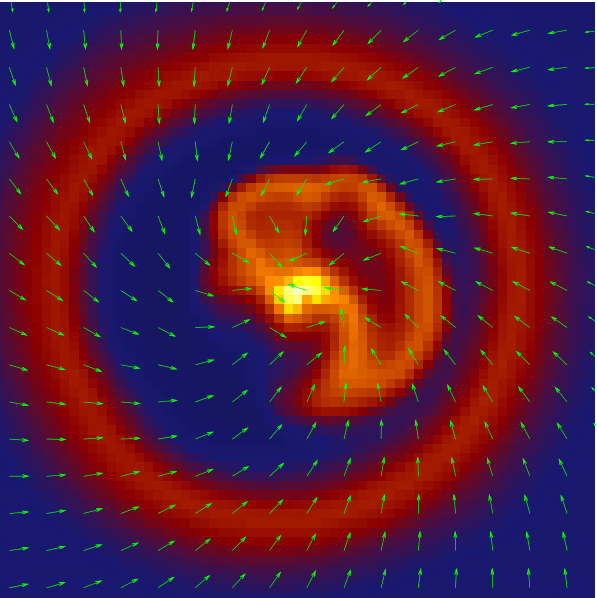

What about magnetic fields?
Help! Where is the disk?!
Santos-Lima et al. 2012
Hydro
ideal MHD
Magnetic braking catastrophe
Angular momentum is transported too efficiently away from the disk
magnetohydrodynamics
ideal MHD
Ohmic dissipation
Hall
ambipolar diffusion
Non-ideal
Non-ideal MHD
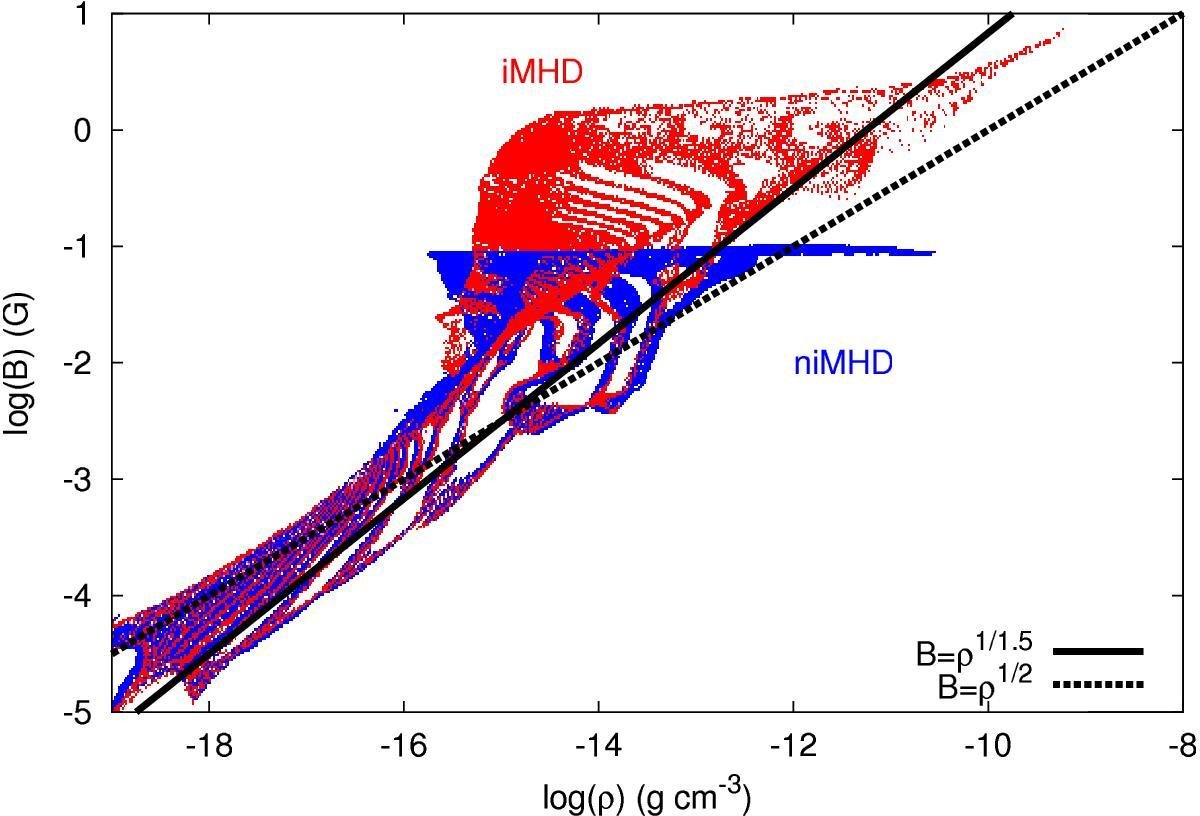
Masson et al. 2016
resistivities quench pile-up of magnetic field
avoids magnetic braking catastrophe
see Hennebelle et al. 2016 or Lee et al. 2021 for analytical studies
more references in reviews by Wurster & Li '18, Tsukamoto et al. '23, Küffmeier '24
History of modeling disk formation




What about magnetic fields?
Help! Where is the disk?!
Ohmic, Ambipolar, Hall
Santos-Lima et al. 2012
Hydro
ideal MHD
non-ideal MHD
non-ideal MHD is not a single parameter that is turned on or off!
It depends on ionization fraction.
Achtung!
see Wurster et al. 2018, Kuffmeier et al. 2020; reviews by Tsukamoto et al. 2023, Kuffmeier submitted
Effect of ionization on disk size
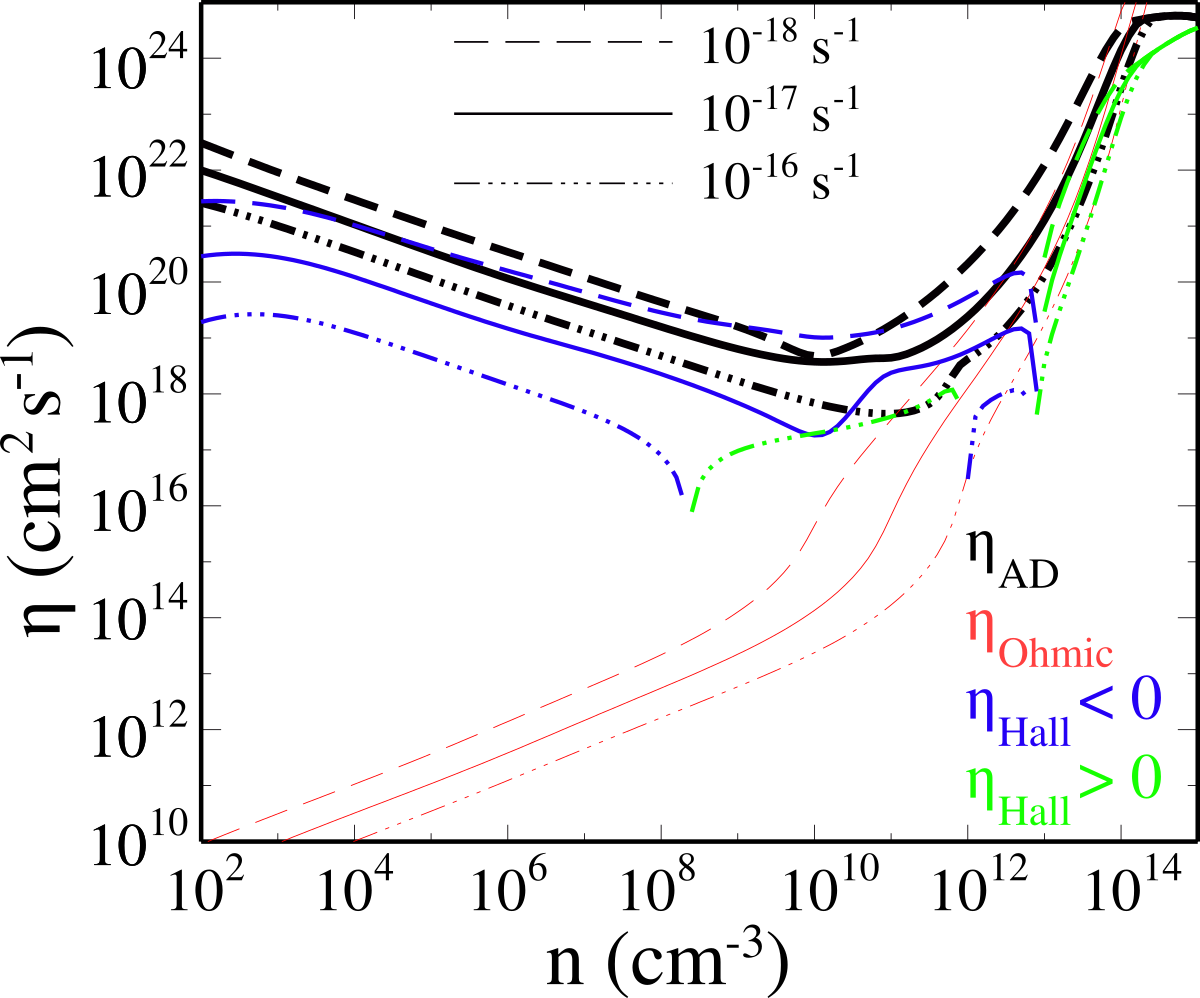
Küffmeier, Zhao & Caselli 2020; see also Wurster et al. 2018
increasing ionization rate
enhanced magnetic braking
smaller disks
Effect of ionization on disk size
increasing ionization rate
enhanced magnetic braking
smaller disks
Küffmeier, Zhao & Caselli 2020

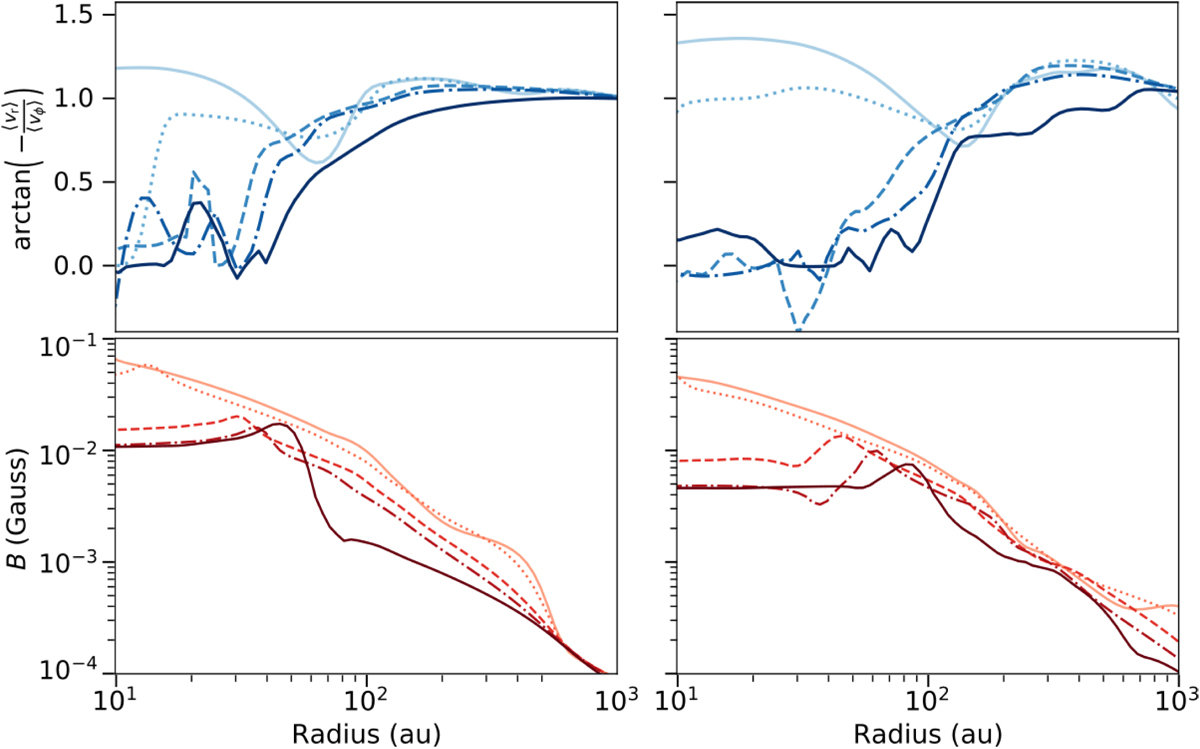

rotation
infall
from light to dark colors: high to low ionization rates
see also Wurster et al. 2018
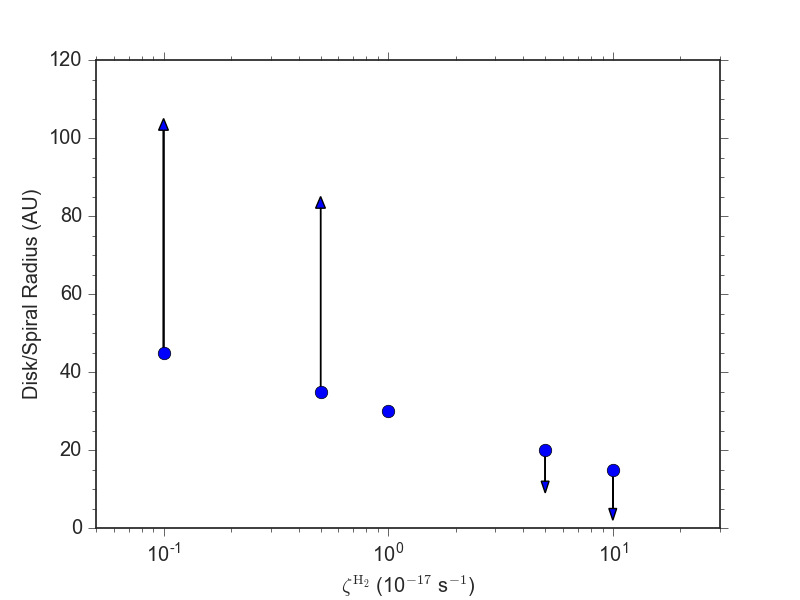
Effect of ionization on disk size
increasing ionization rate
enhanced magnetic braking
smaller disks

Maps of CR-ionization rates (e.g., NGC 1333 Pineda et al. 2024, or AG 351 & AG 354 Sabatini et al. 2023)
Küffmeier, Zhao & Caselli 2020; see also Kobayashi et al. 2023



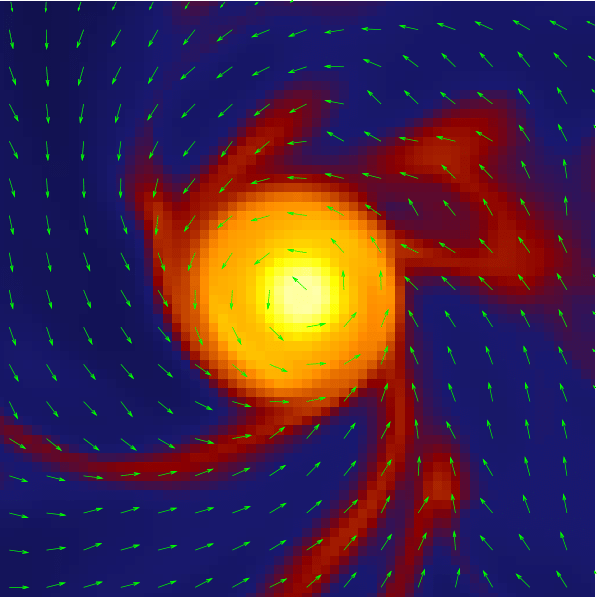

What about magnetic fields?
Help! Where is the disk?!
Ohmic, Ambipolar, Hall
Turbulence
Santos-Lima et al. 2012
Hydro
ideal MHD
non-ideal MHD
turbulence + MHD
History of modeling disk formation
for more references, see reviews (e.g., Wurster & Li 2018, Tsukamoto et al. 2023, Küffmeier 2024)
Modeling disk formation
Credit: Christian Granzow Holm
Is this the full picture?
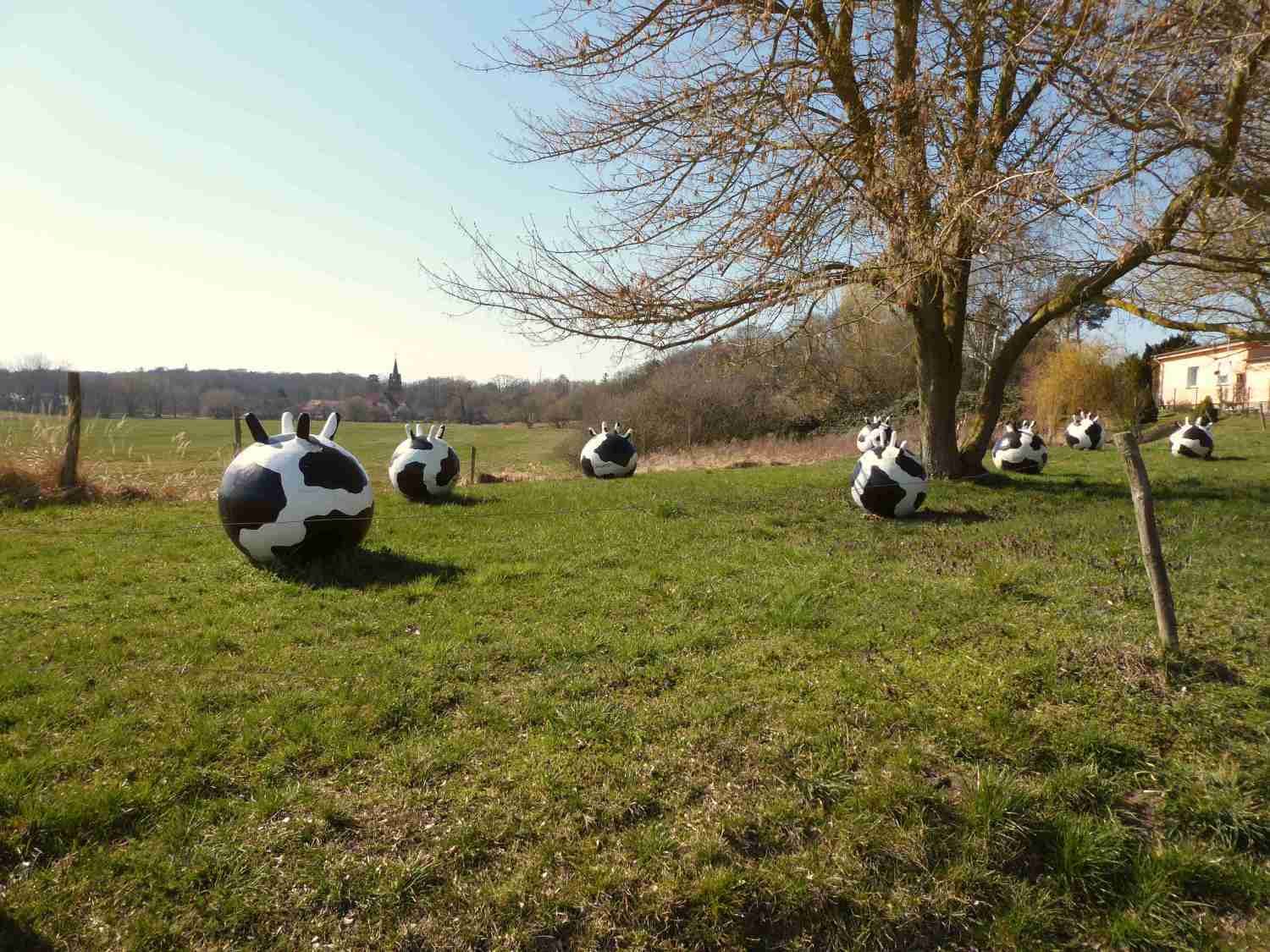
Preliminary take-aways
- Accretion requires angular momentum transport
- Angular momentum can be transported radially through turbulent viscosity ( -parameter) or through magnetically driven winds
- Ongoing paradigm shift in interpreting accretion disks from viscous accretion disks to predominantly outflow-driven accretion disks (see PPVII reviews by Lesur et al., Pascucci et al.)
- Magnetic fields are important regulators of disk accretion and probably the source of massive early outflows/jets
Michael Küffmeier
Carlsberg Reintegration Fellow at Niels Bohr Institute
Accretion and infall


SU Aur
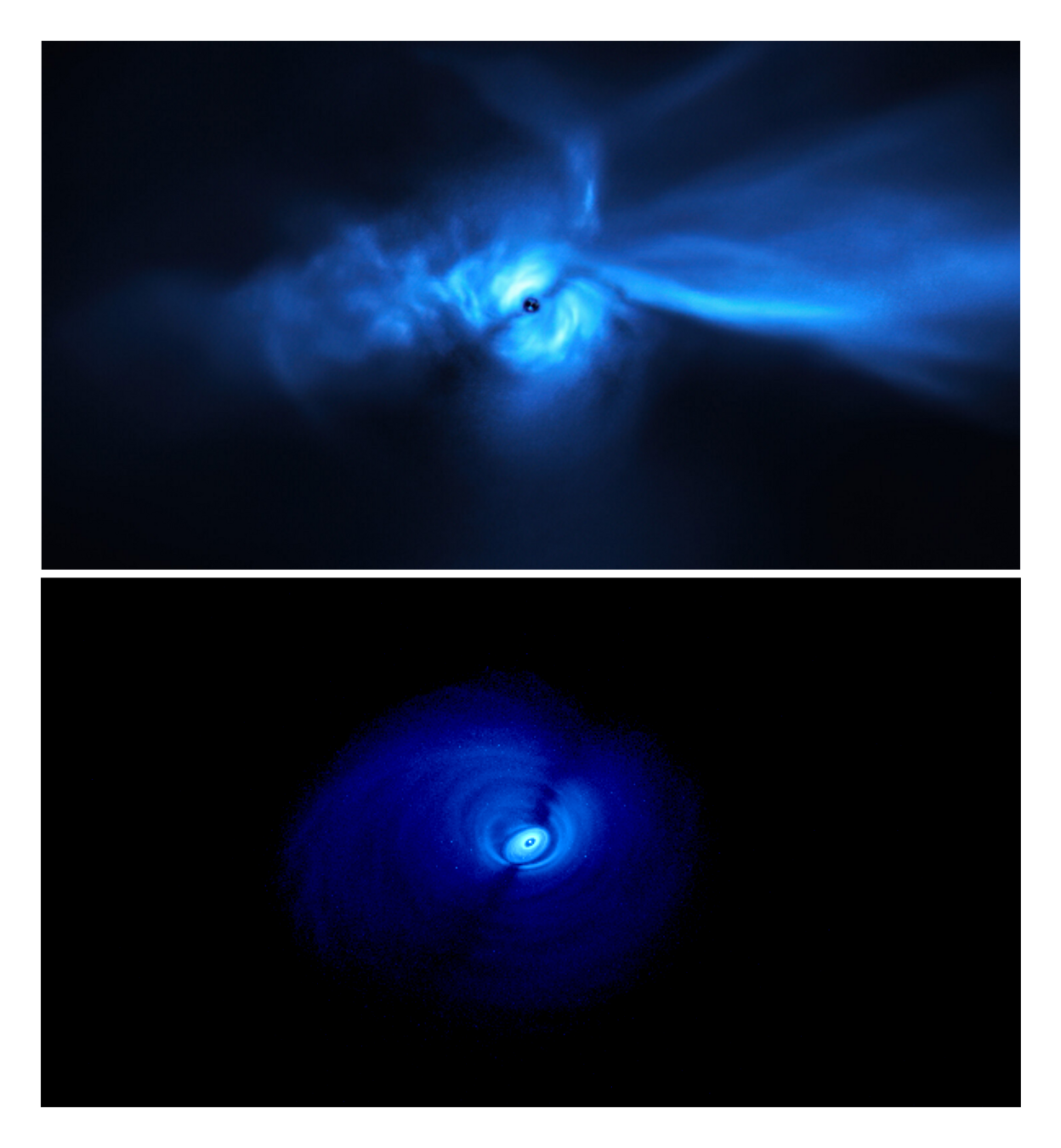

SU Aur
synthetic image
Ginski et al. 2021
Krieger et al. 2021
Overview and history of star-disk formation
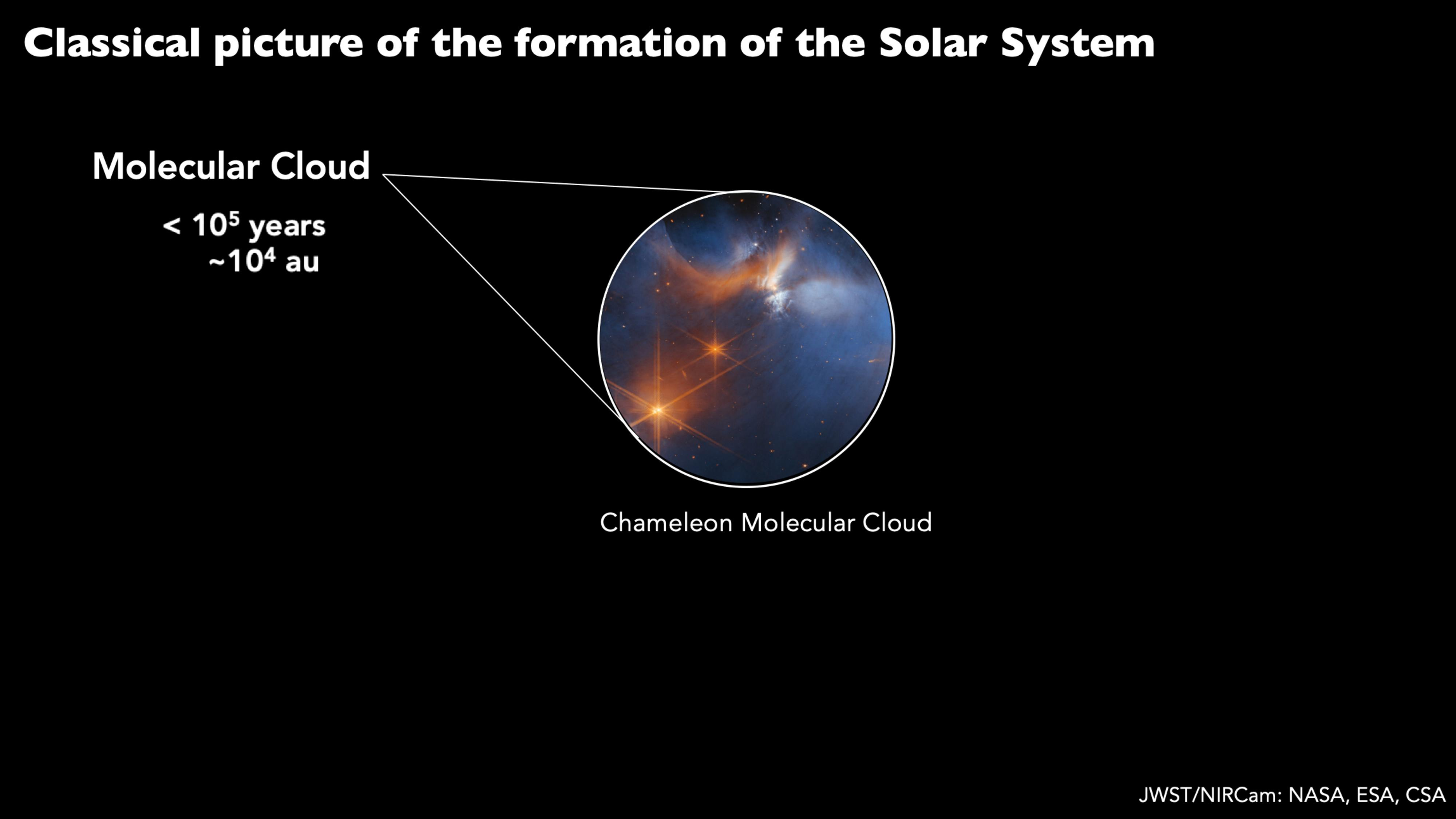
~1 to 10 Myr
~1 to 100 pc
slide credit: G. Perotti
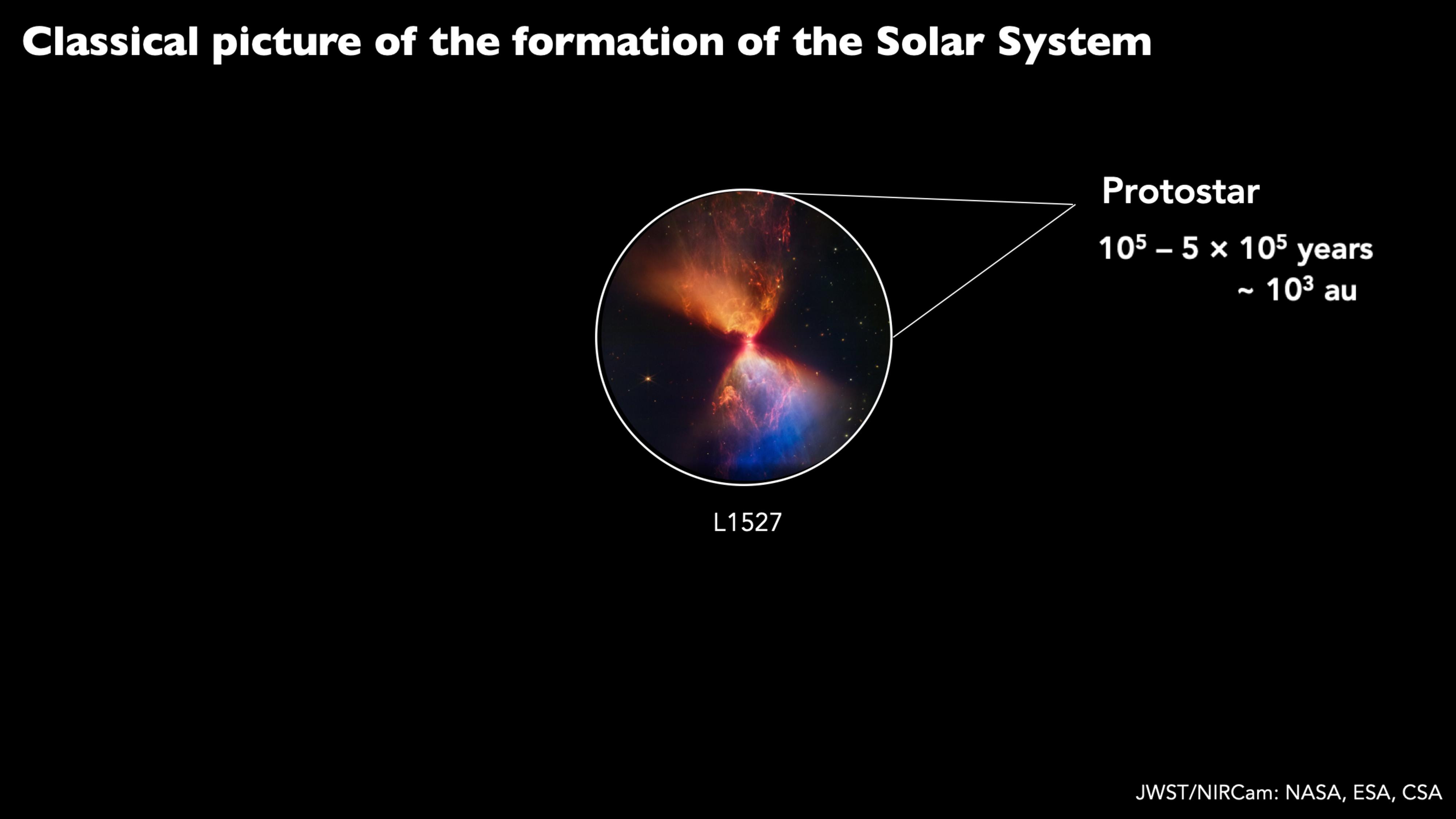
slide credit: G. Perotti
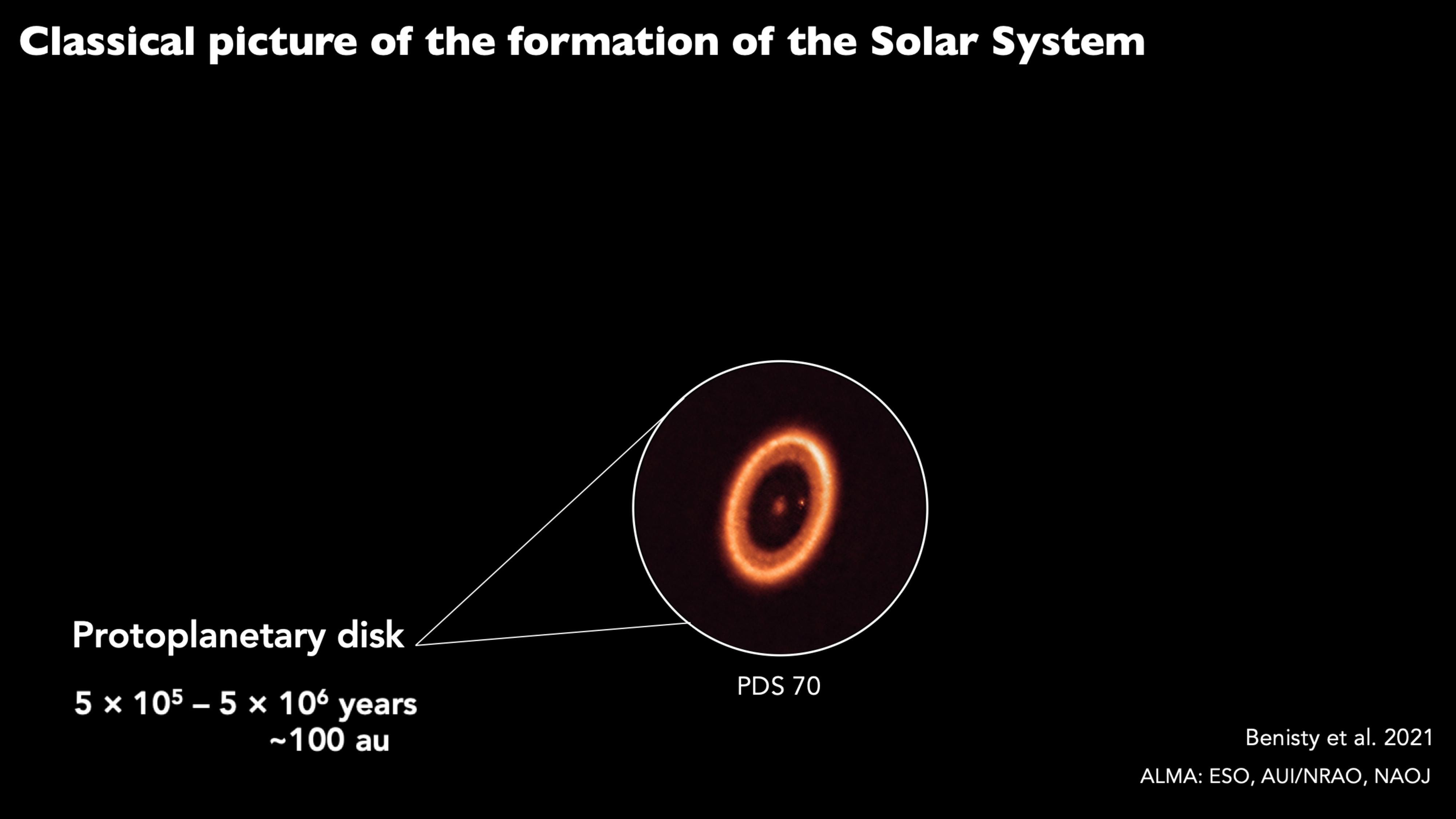
slide credit: G. Perotti
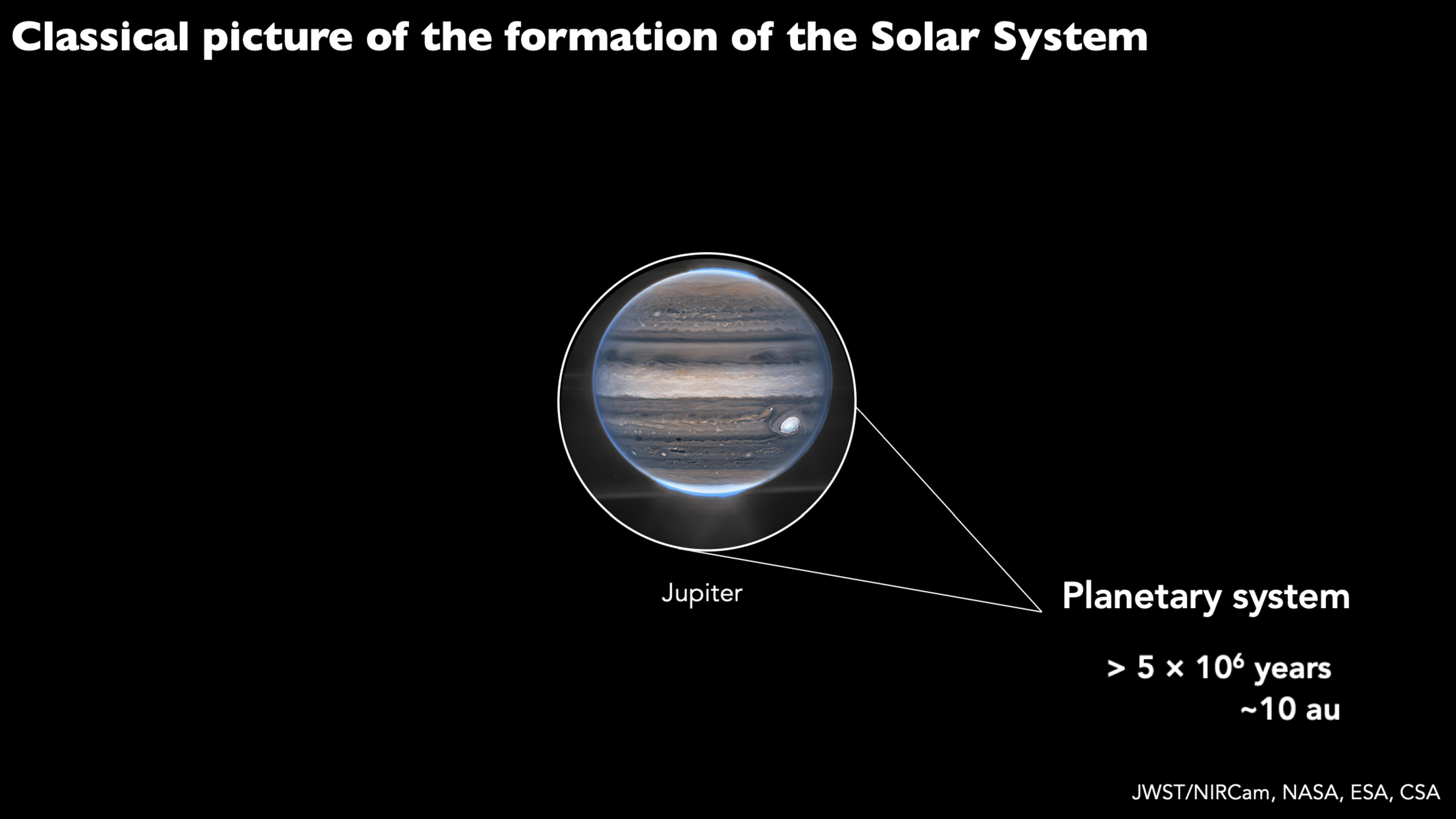
slide credit: G. Perotti

slide credit: G. Perotti
Revisiting star-disk formation from a Giant Molecular Cloud perspective
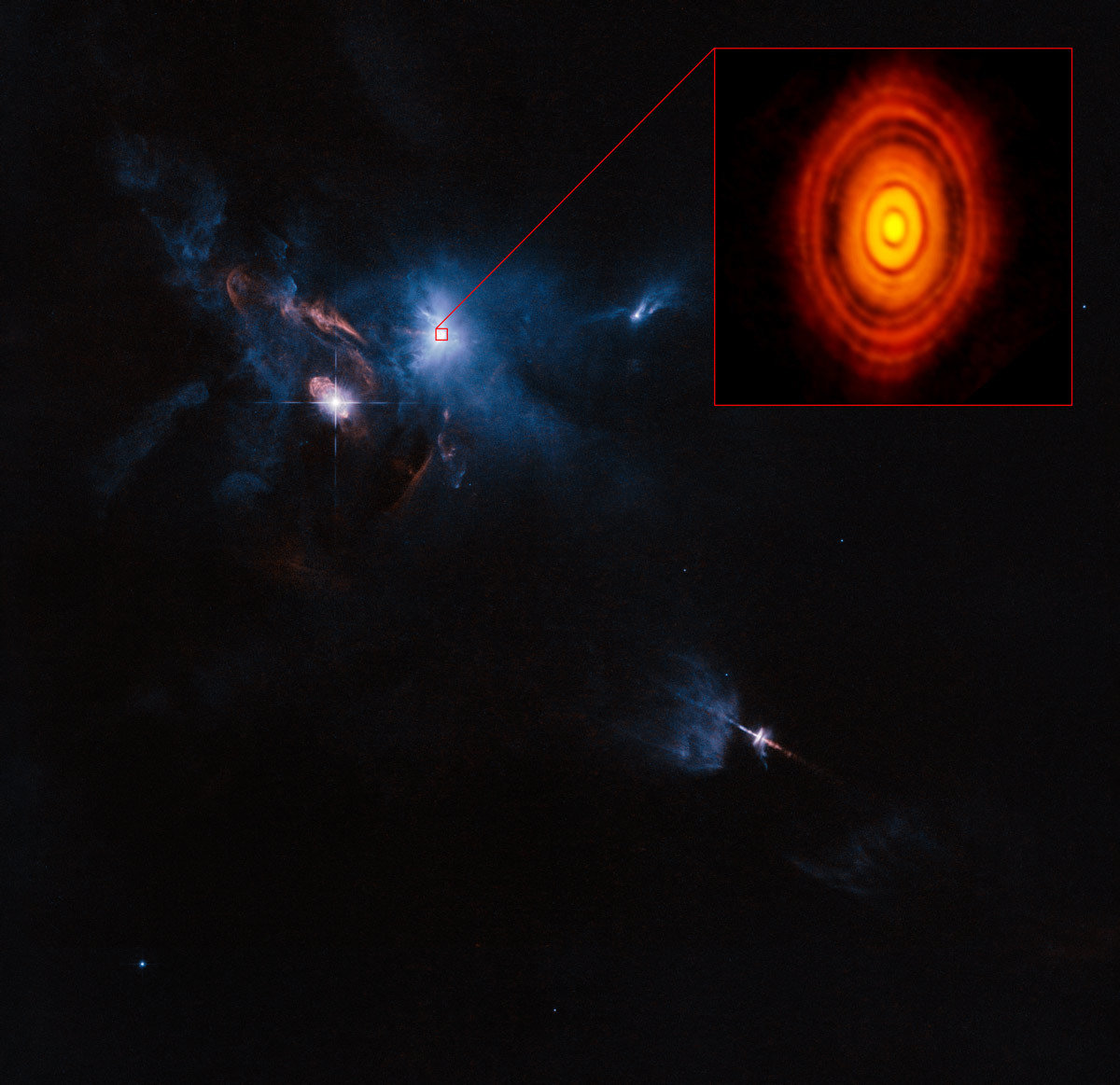
Credit: ALMA (ESO/NAOJ/NRAO)
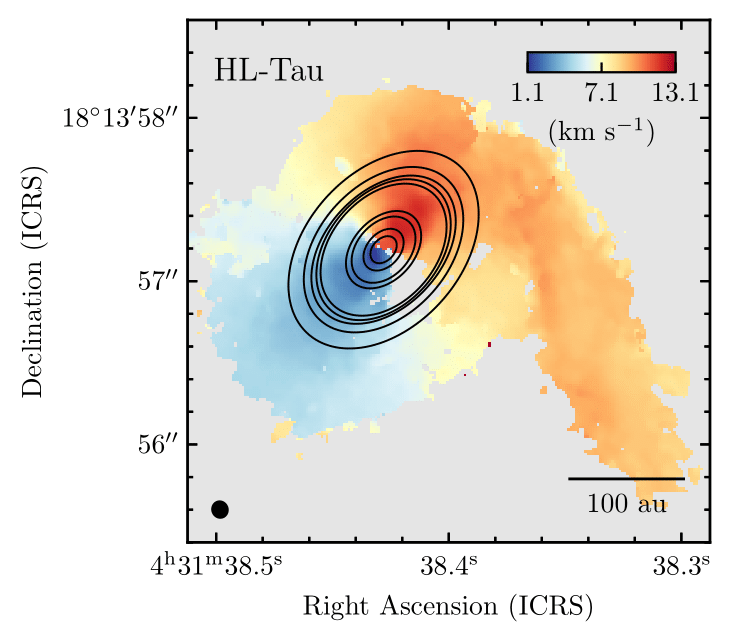
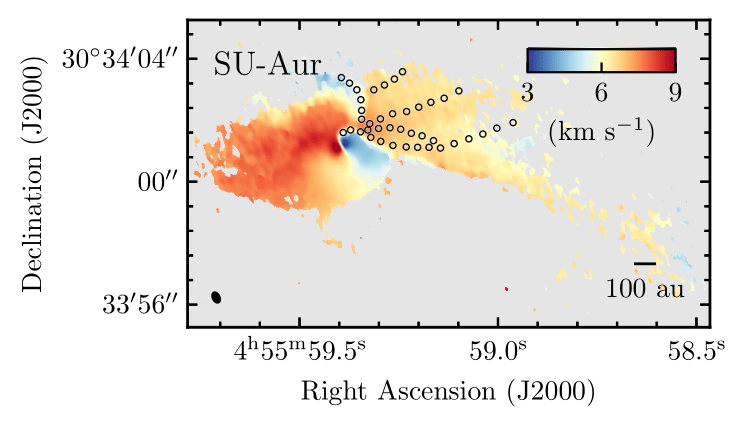
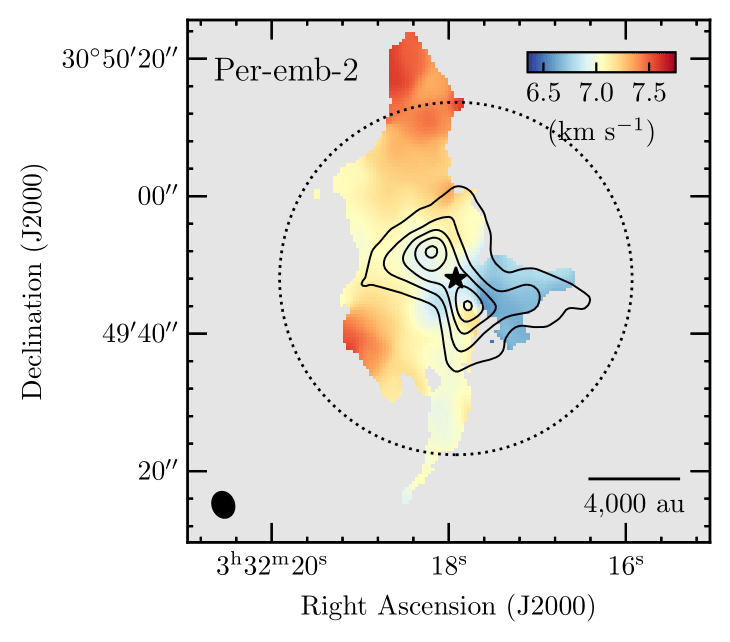
Ginski et al. 2021
Yen et al. 2019
Garufi et al. 2021
Pineda et al. 2020
50 au
BHB1 (Alves+ '20), GM Aur (Huang+ '21), IRS 63 (Segura-Cox in prep.), AB Aur (Grady+ '99 / Fukagawa+ '04, Speedie+ '24), M512 (Grant+ '21, Gupta+ '24, Cacciapuoti+ '24) ...
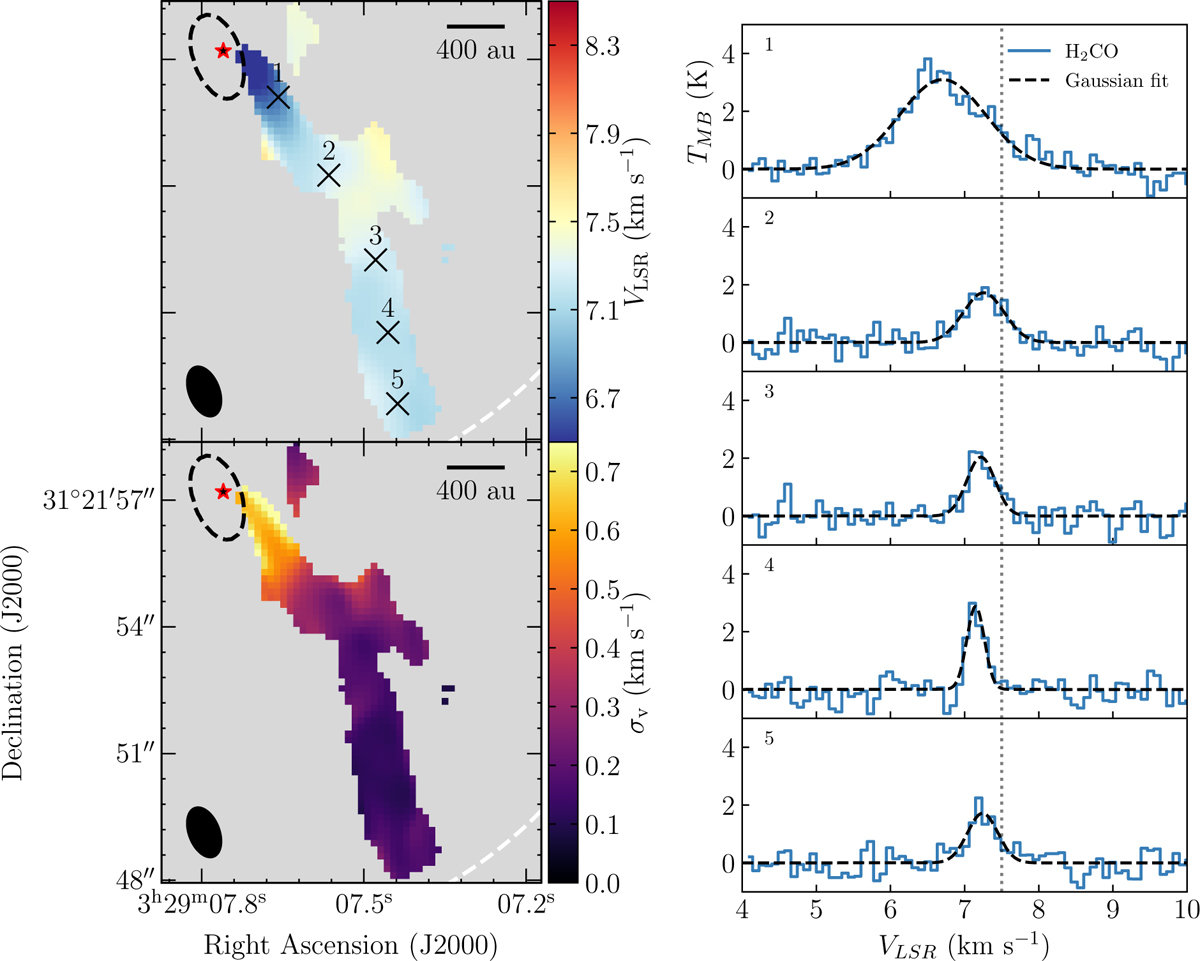
Per-emb-50
Valdivia-Mena et al. 2022
Science question:
Can we get better (statistical) constraints on the relevance and importance of (late) infall from existing simulation data?
Streamers:
A. Garufi's lectures

Adaptive mesh refinement
Adaptive mesh refinement
Model star formation in a Molecular Cloud
isothermal magnetohydrodynamical (MHD) with driven turbulence
adaptive mesh refinement (AMR) simulations with RAMSES
maximum resolution: ≈25 au (level of refinement: 15), root grid about ≈1600 au (level 9)
Total mass: 3000 solar masses
periodic boundary conditions
altogether 321 sink particles at last snapshot (2 Myr after the formation of the first star)

simulation setup including detailed description of sink recipe presented in Haugbølle+2018
Küffmeier, Jensen & Haugbølle '23
Late infall is common for stars
On average, even solar mass stars gain ~50 % of their final mass through accretion of initially unbound material
Note that some protostars still accrete after 1.2 Myr
Küffmeier, Jensen & Haugbølle '23
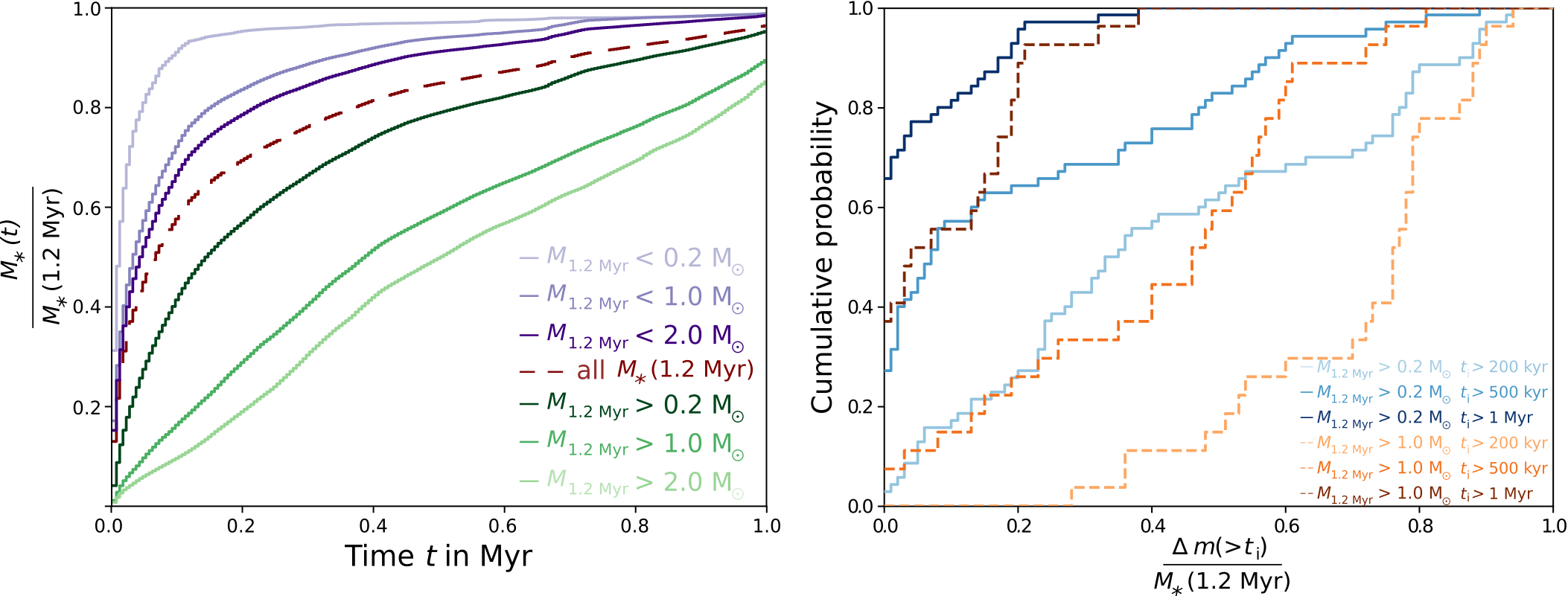
(Pelkonen et al. 2021)
Origin of accreting gas
Two phase process:
Initial collapse followed by varying amount of post-collapse infall
(see also Smith+ 2011, Pelkonen+ 2021)
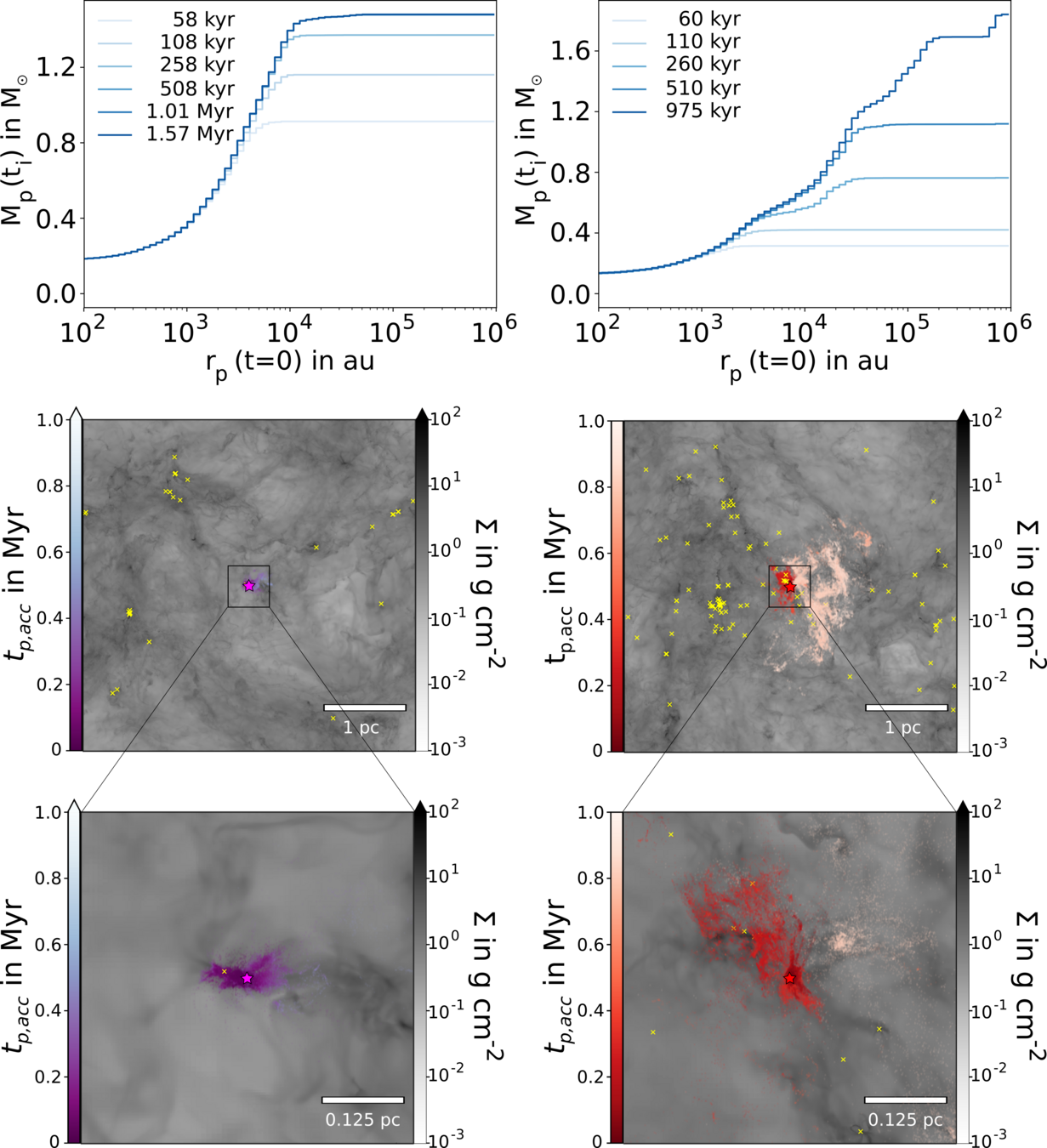

Küffmeier, Jensen & Haugbølle '23
Origin of accreting gas
"The assumption of spherical symmetry cannot be applied to the majority of collapsing cores, and is never a good description of how stars accrete gas from outside the original core radius."
(Smith et al. 2011)
Implications of (late) infall
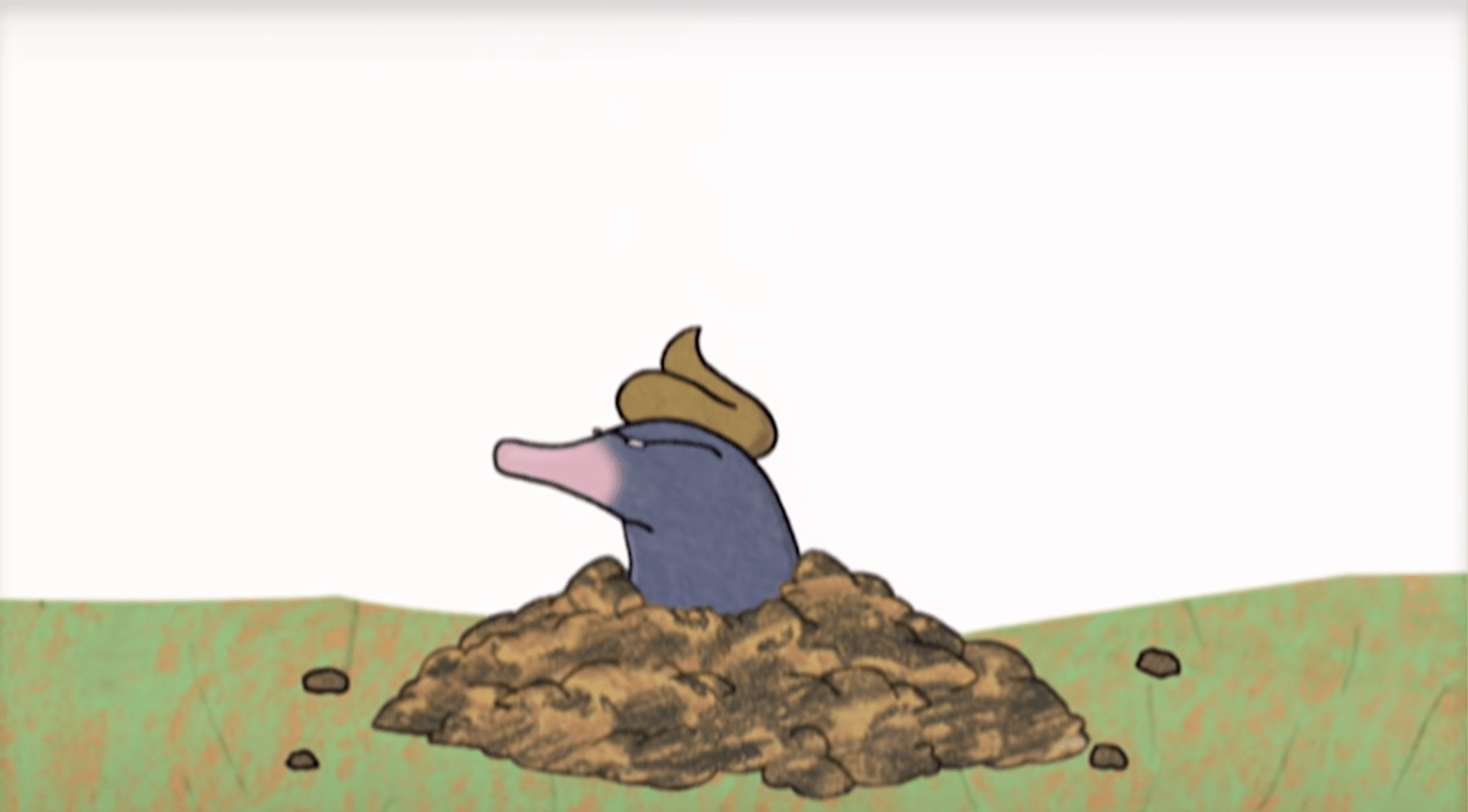
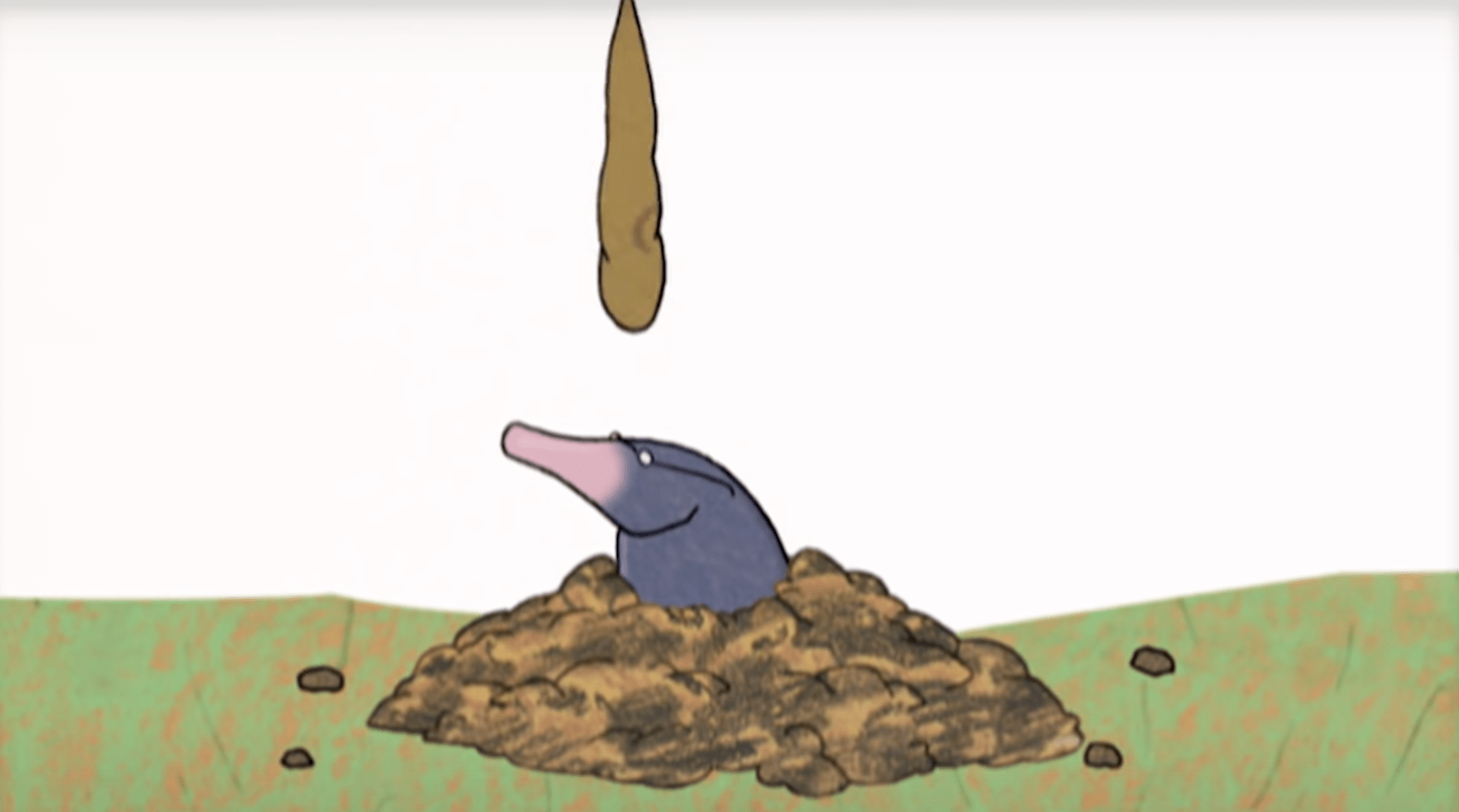

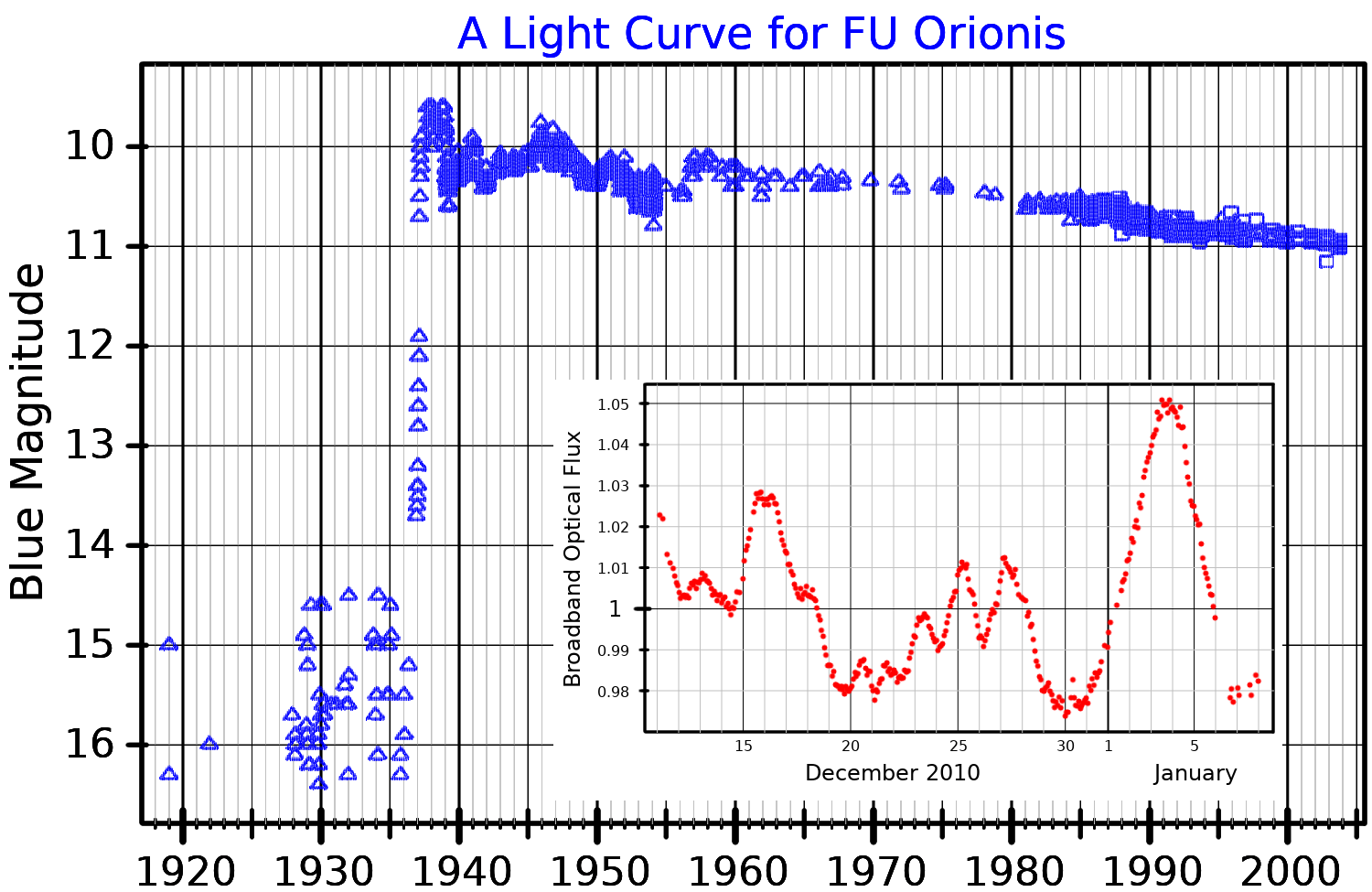
Late infall causes accretion bursts
Intriguing explanation of luminosity bursts
infall may also trigger smaller scale variations by causing more subtle disk instabilities
data from Clarke+ '05
YSOs can appear younger than they really are
How old is the protostar?



Küffmeier, Jensen & Haugbølle '23
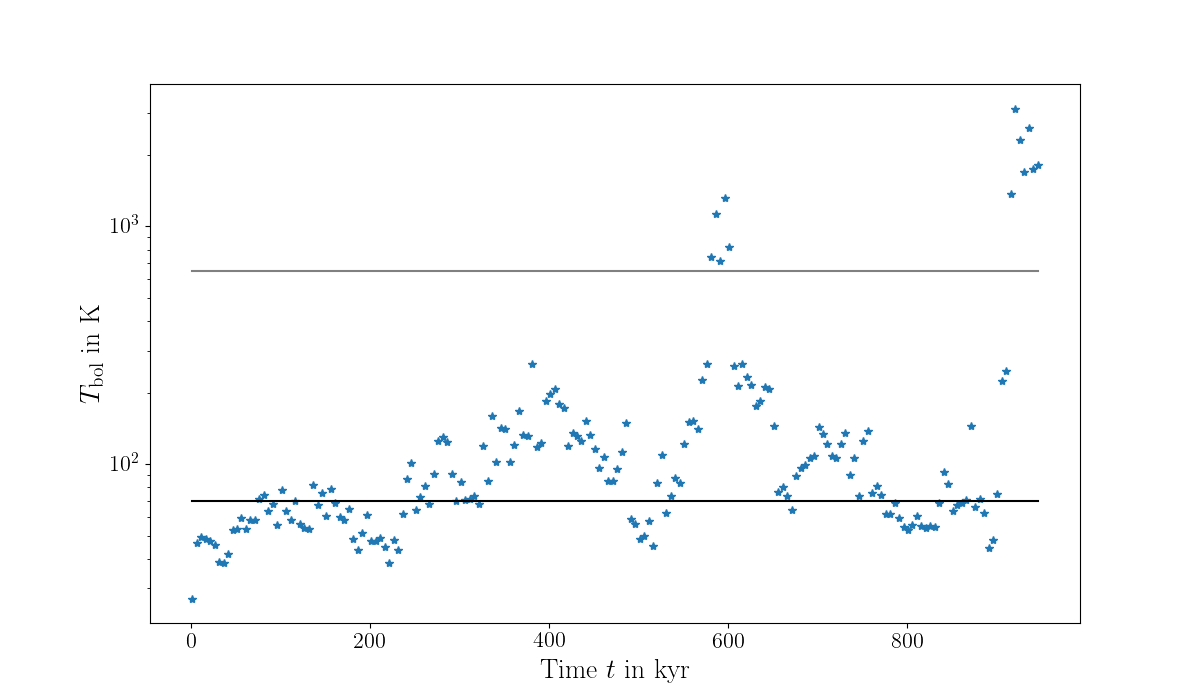
Class I
Class 0
Class II
A poor analogy to a spring school
Session start
Coffee break!






Spreading vs wind-driven?
Manara et al. 2023
Caveat!
Infall matters. Disks can easily be wind-driven and yet grow in size through infall of gas with high angular momentum.


Long et al. 2022
?
Angular momentum budget
- Large scatter of ang. mom.
- Increasing specific angular momentum for increasing final stellar mass
Specific angular momentum computed from all accreting tracer particles at the first snapshot after star formation
- subtle correlation with mass (inherited by disks??)
"We find marginal relationships between disk sizes and M*." (Long+ 2022)
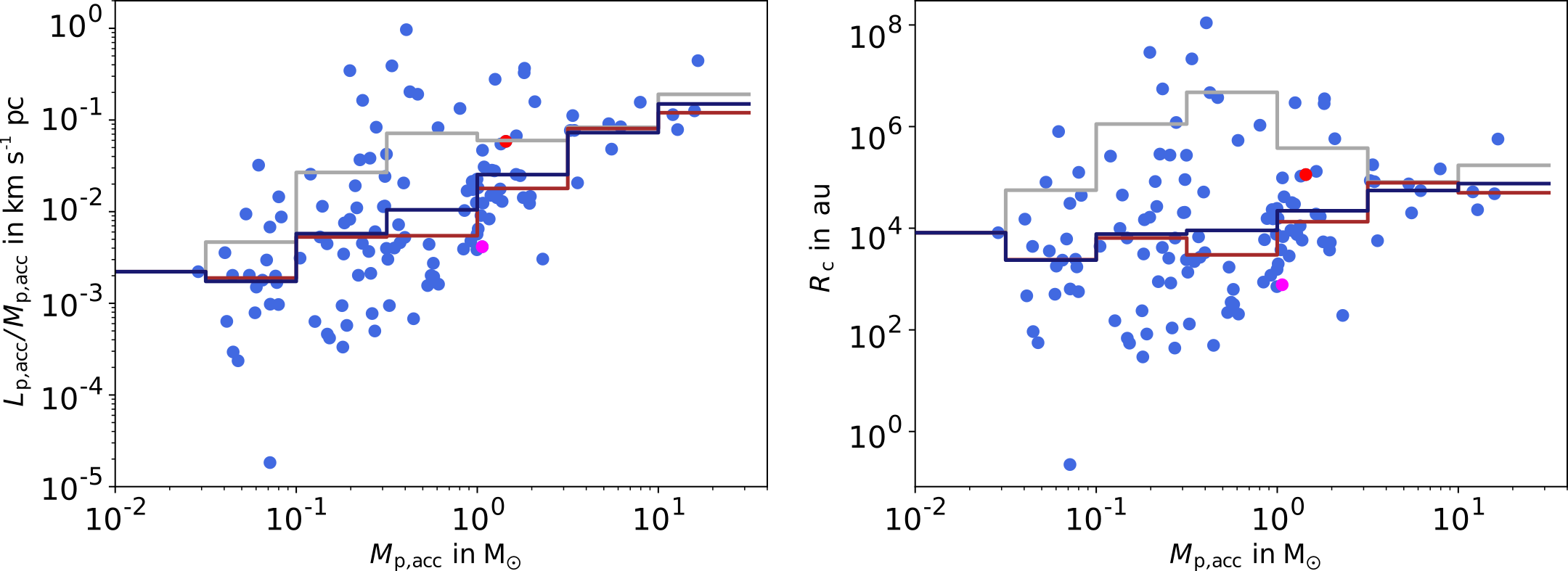
Küffmeier, Jensen & Haugbølle '23

Long et al. 2022
see also Padon et al. 2024
On average, stars with increasing final mass undergo prolonged infall
Orientation of star-disk systems can change substantially

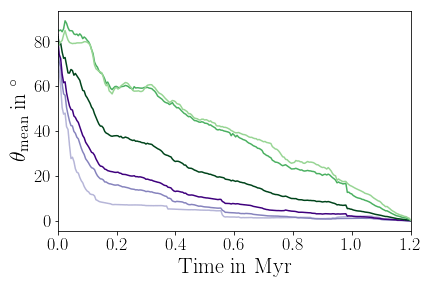
Orientation of infall
Küffmeier, Haugbølle, Pineda & Segura-Cox 2024
Post-collapse infall is more anisotropic than initial collapse
Anisotropic accretion
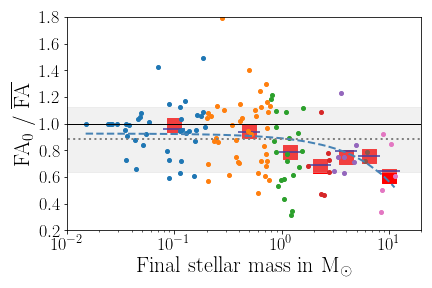
FA = 0: perfectly isotropic accretion
FA = 1: maximum anisotropic accretion

Küffmeier, Haugbølle, Pineda & Segura-Cox 2024
Streamers (and shadows) as signs of infall
Formation of misaligned configuration
Observable as shadows in outer disk
Küffmeier, Dullemond, Reissl & Goicovic 2021

SU Aur (Ginski et al. 2021)
300 au

Krieger, Küffmeier et al. 2024
Open questions and preliminary results
Do we really know disk "lifetimes"?

Polnitzky et al. 2025 in prep
Fraction reflecting occurrence of infall events instead of disk age?
Are "Peter Pan" disks around >10 Myr old stars in fact "Dorian Gray" disks?
Trails of gas: signs of Bondi-Hoyle-Lyttleton accretion or photoevaporative wind?
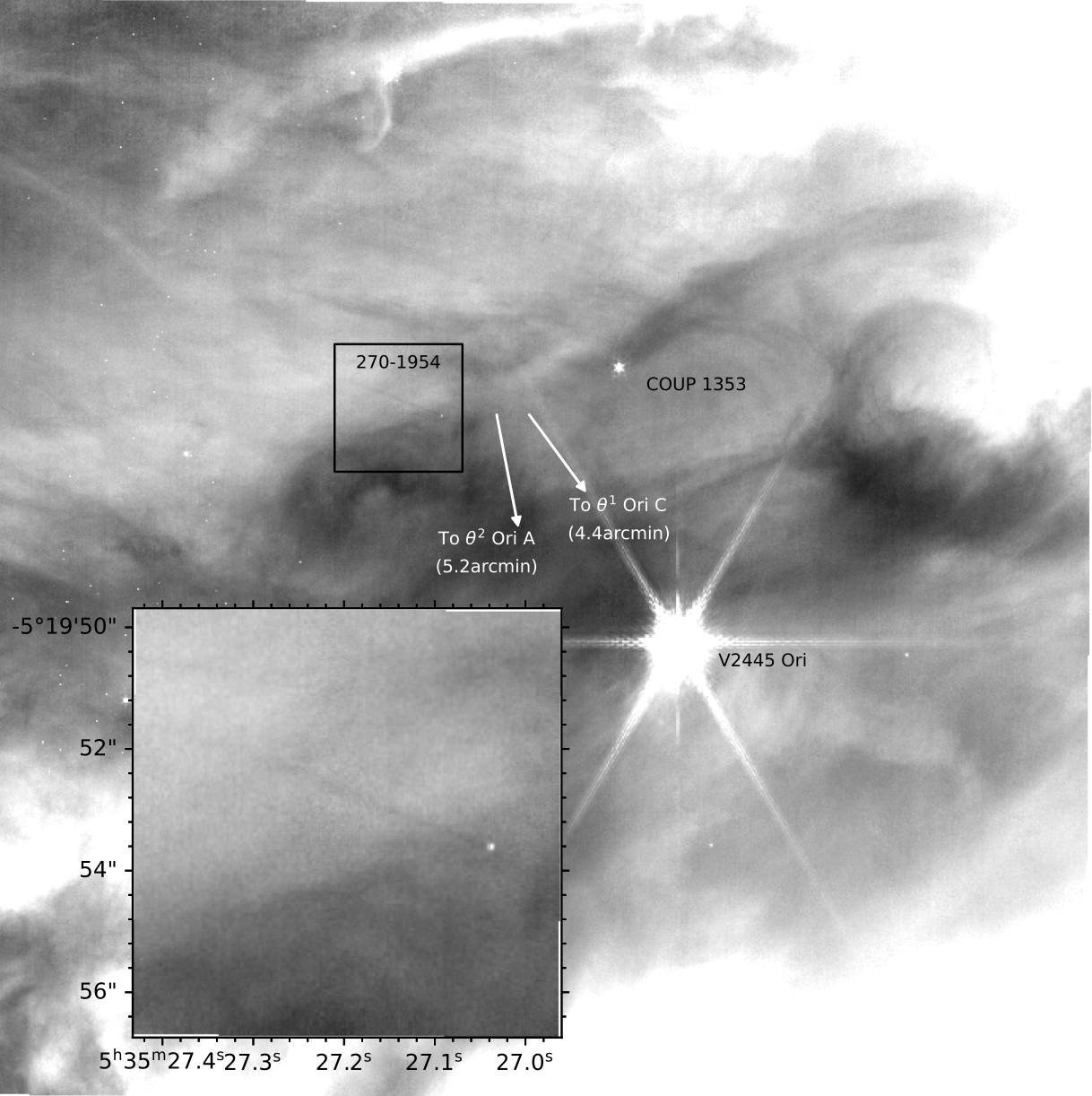
Haworth et al. '25
Bondi-Hoyle(-Lyttleton) accretion (poster Ashtari-Jolehkaran; Padoan+ '24, Winter+ '24, Küffmeier '24)
for external photoevaporation see posters by Aru and Gkimisi
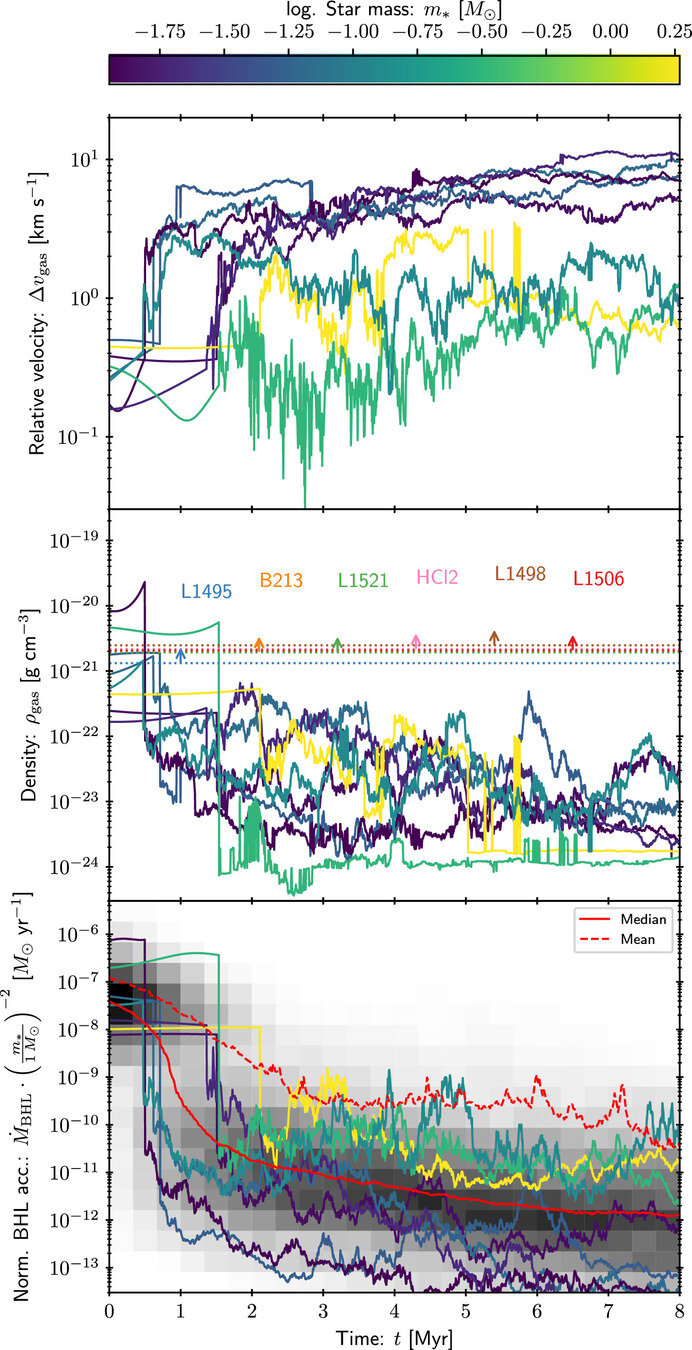
Winter+ '24
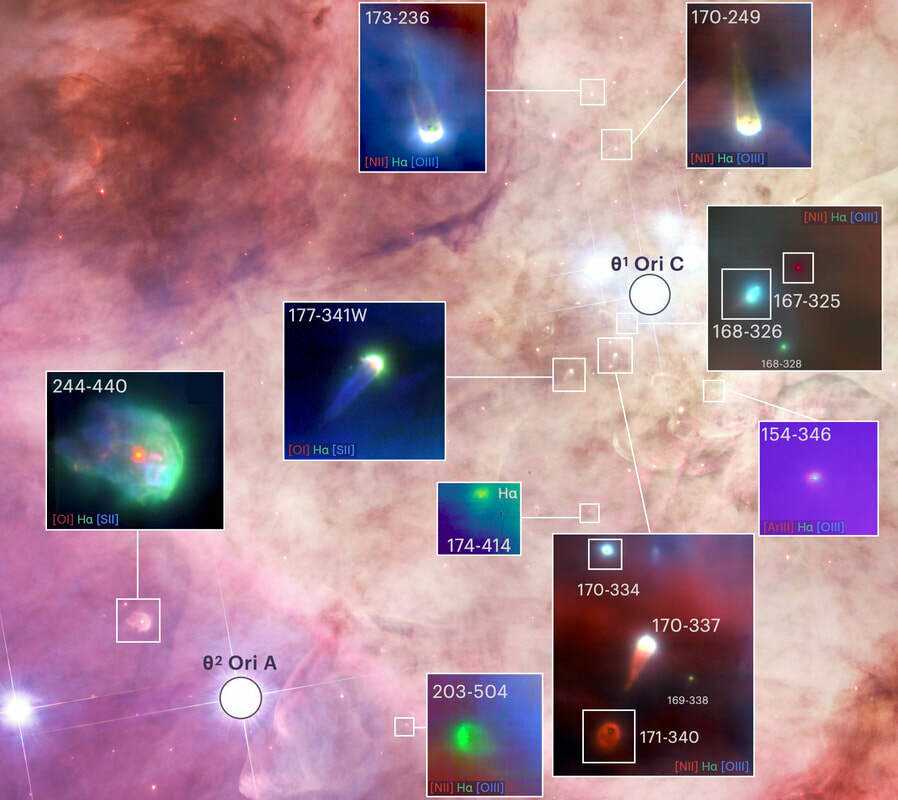
Aru+ '24
Zoom-in on embedded stars

Küffmeier et al.
2019
Küffmeier et al. 2018

Küffmeier, Reißl et al. 2020
bridge structure similar to IRAS 16293--2422 (e.g. Sadavoy+ 2018, van der Wiel+ 2019, Maureira+ 2020)
~1500 AU
Pro: self-consistent initial and boundary conditions for star formation
Con: computationally more expensive, more difficult analysis

for a similar concept, see also Lebreuilly et al. 2024
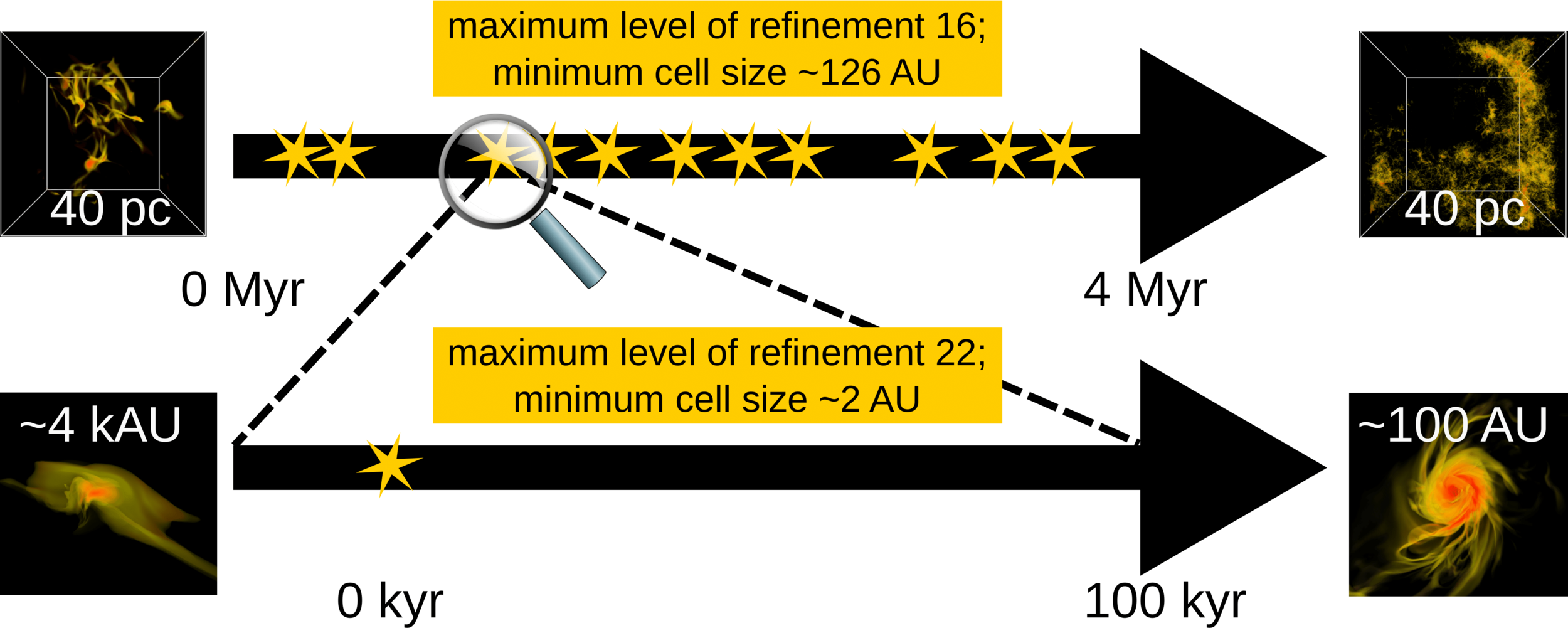
Zoom-in method
Küffmeier et al. 2017
- adaptive mesh refinement
- ideal magnetohydrodynamics
- turbulence driven by supernovae
- stars modelled as sink particles
Zoom-in method
- adaptive mesh refinement
- ideal magnetohydrodynamics
- turbulence driven by supernovae
- stars modelled as sink particles

Christian G. Holm

Granzow Holm, Lambrechts, Kuffmeier et al. in prep
Zoom-in simulations
Christian G. Holm

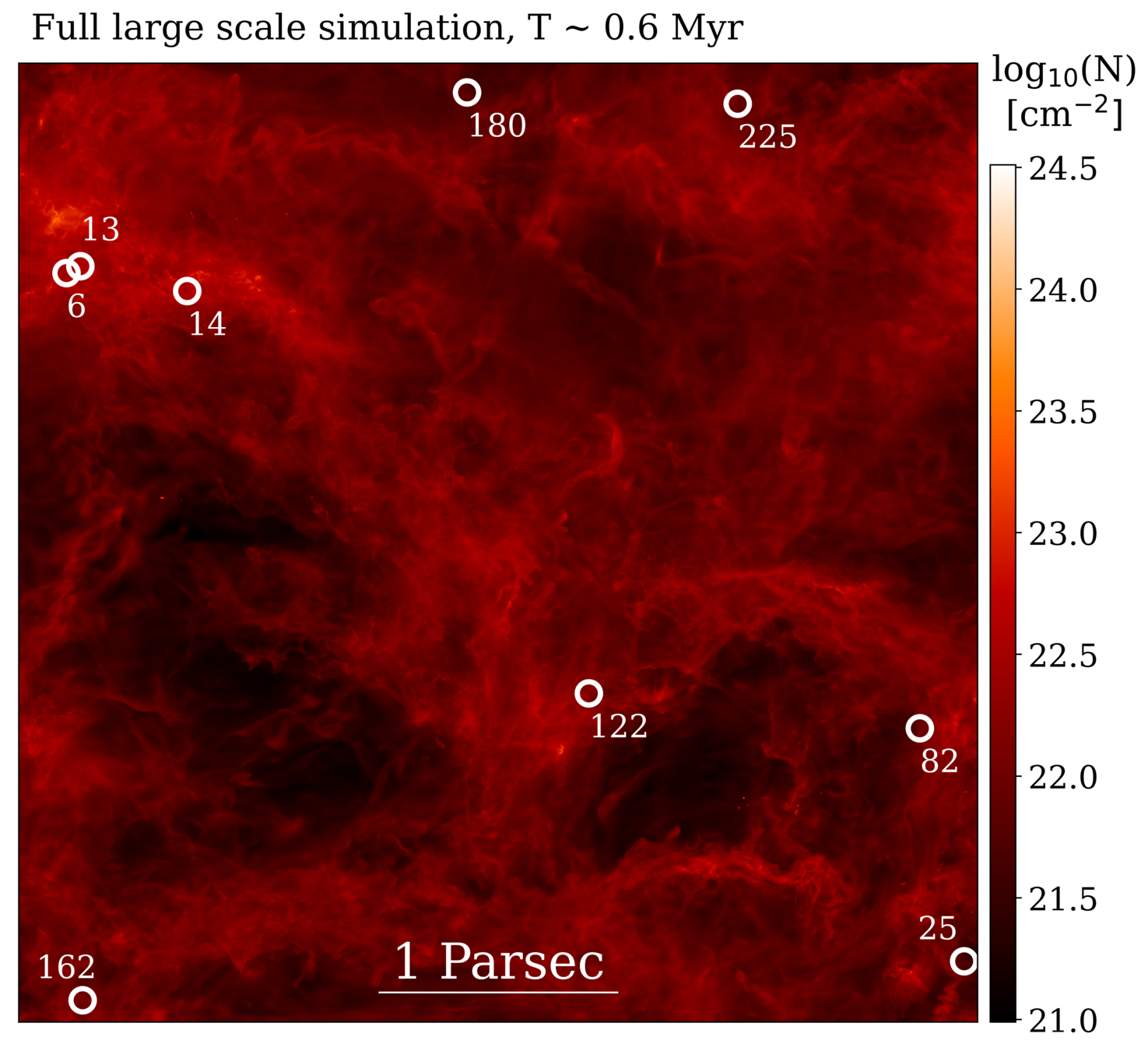
How does (early) infall shape disk formation?
Christian G. Holm

Zoom-in simulation*, ~1 au resolution in disk, barotropic equation of state
*(run with DISPATCH: used only 1 instead of 24 nodes, yet faster than RAMSES)
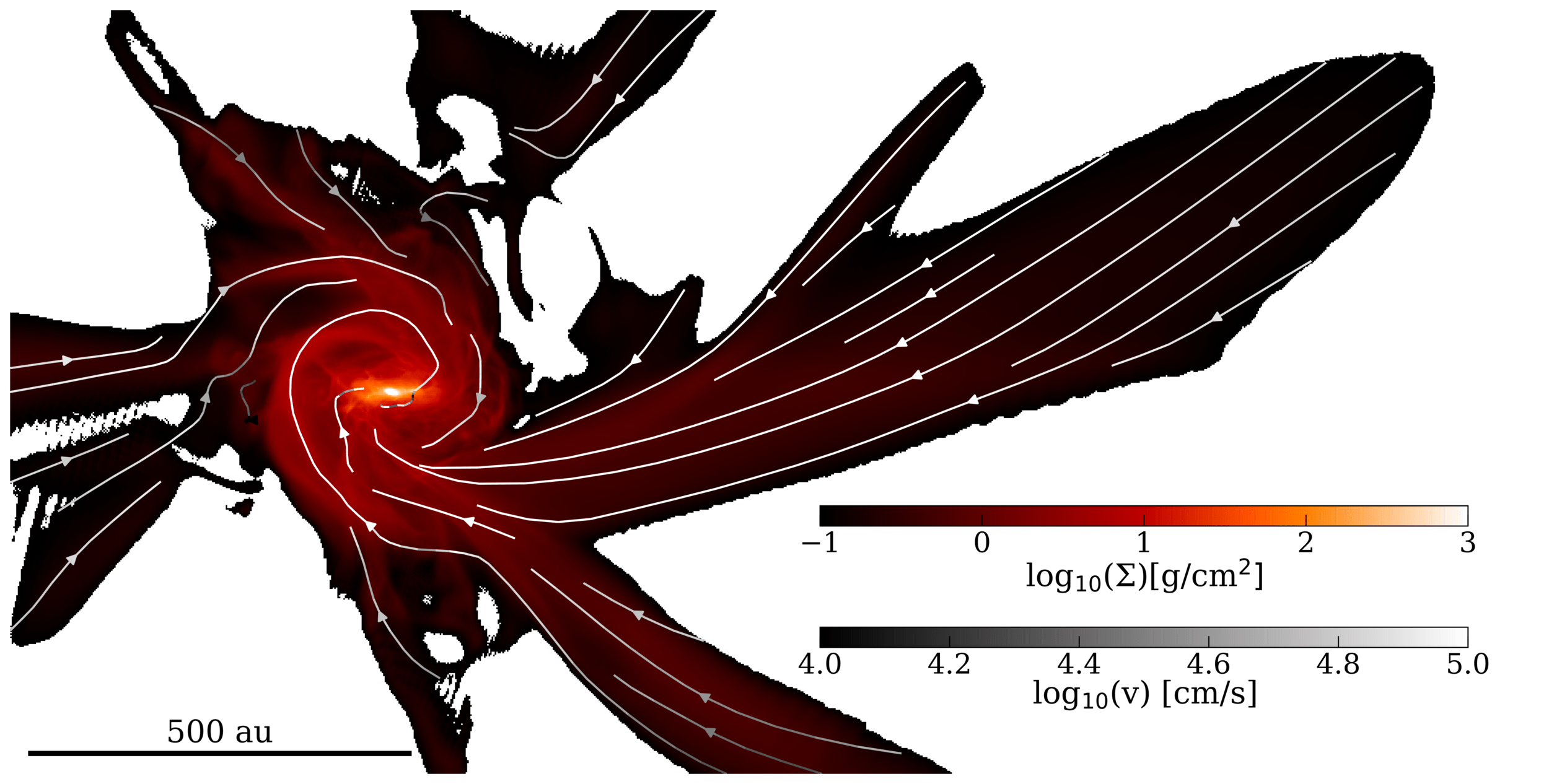
Young embedded disks
Christian G. Holm

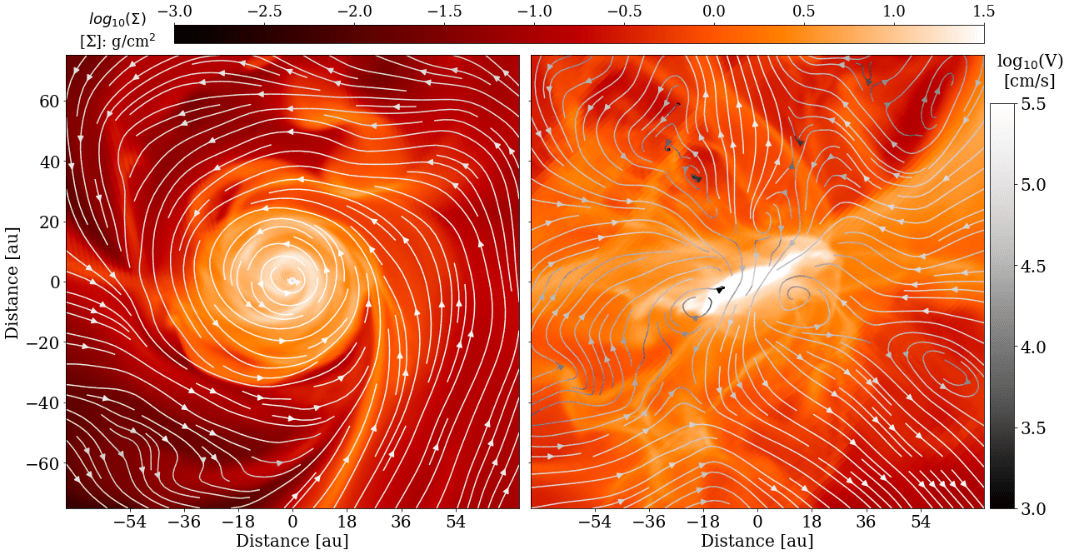
Zoom-in simulation*, ~1 au resolution in disk, barotropic equation of state
*(run with DISPATCH: used only 1 instead of 24 nodes, yet faster than RAMSES)
Christian G. Holm
Gas accretes through the disk (little polar accretion)

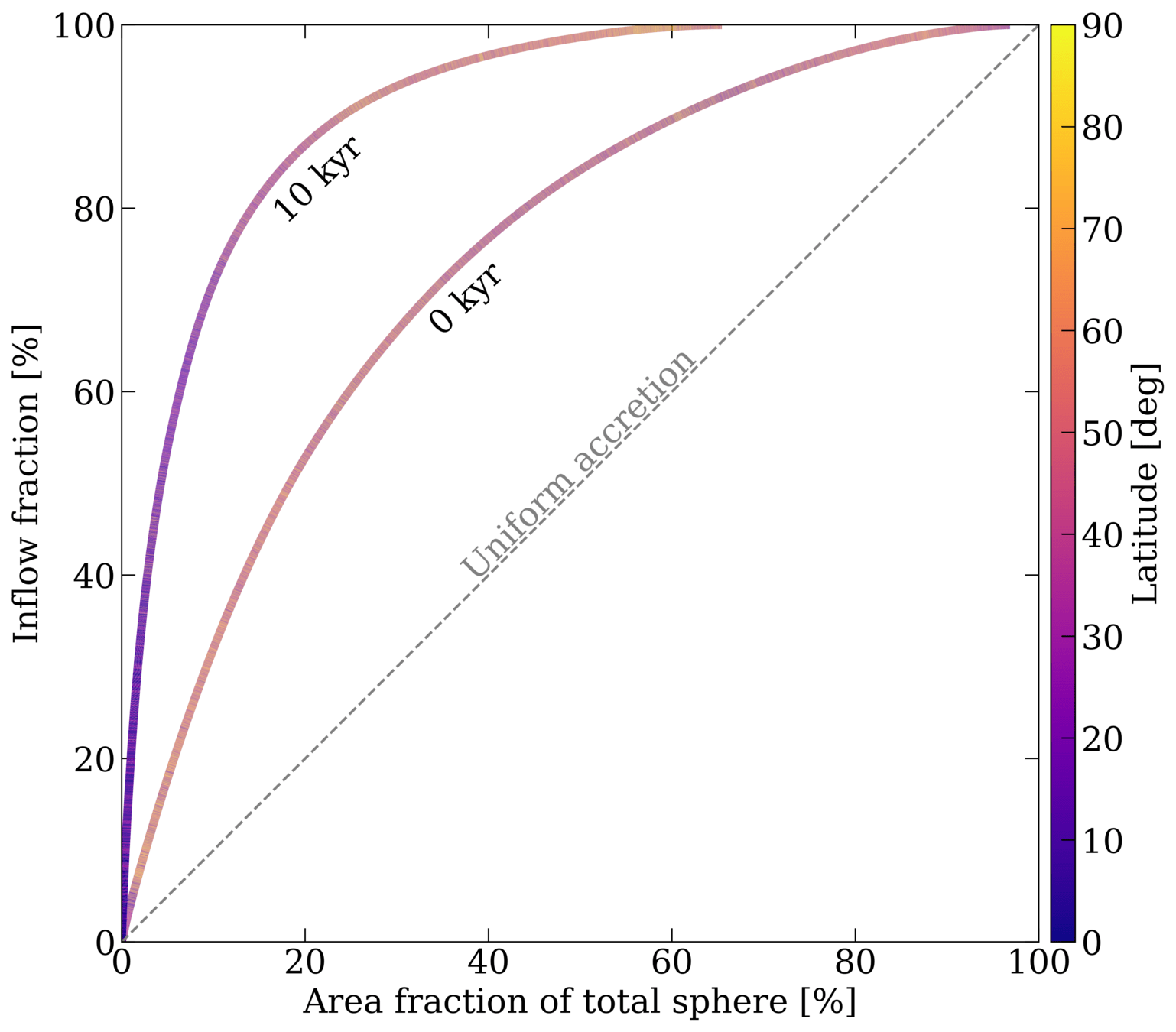
Christian G. Holm

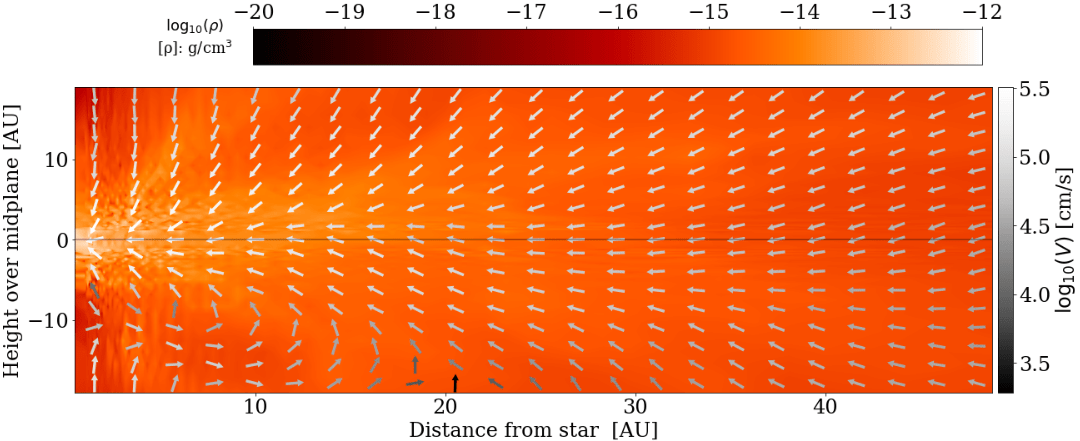
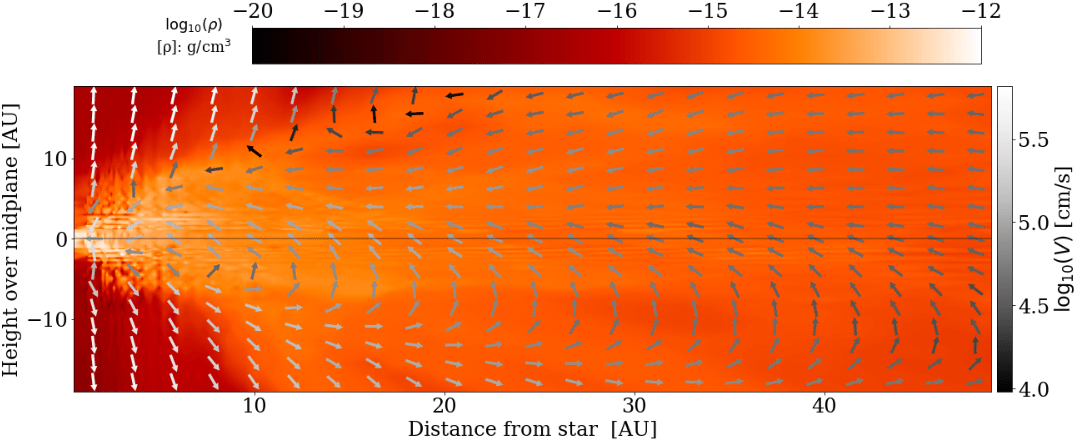
star A, t = 13 kyr
star A, t = 25 kyr
strong magnetic braking,
strong outflow
Gas accretes through the disk (little polar accretion)
Christian G. Holm
How do outflows affect disk formation?



star A, t = 13 kyr
star A, t = 25 kyr
strong magnetic braking,
strong outflow
Prospect to compare with observations of outflows (e.g., ALMA-DOT, PI: Podio)
Simulation: Granzow Holm
Visualizations: Berlok
Zooming in on late phase

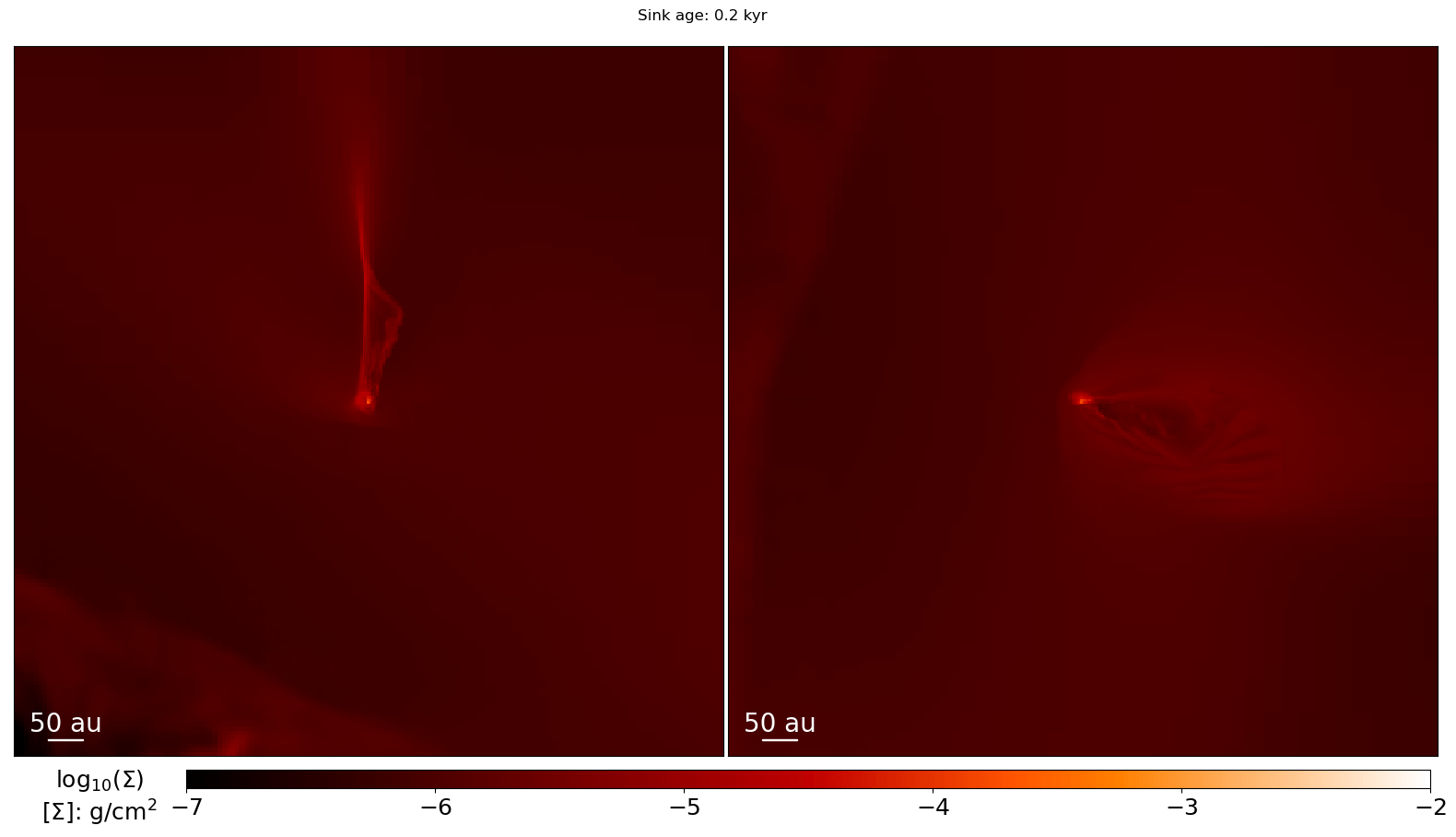
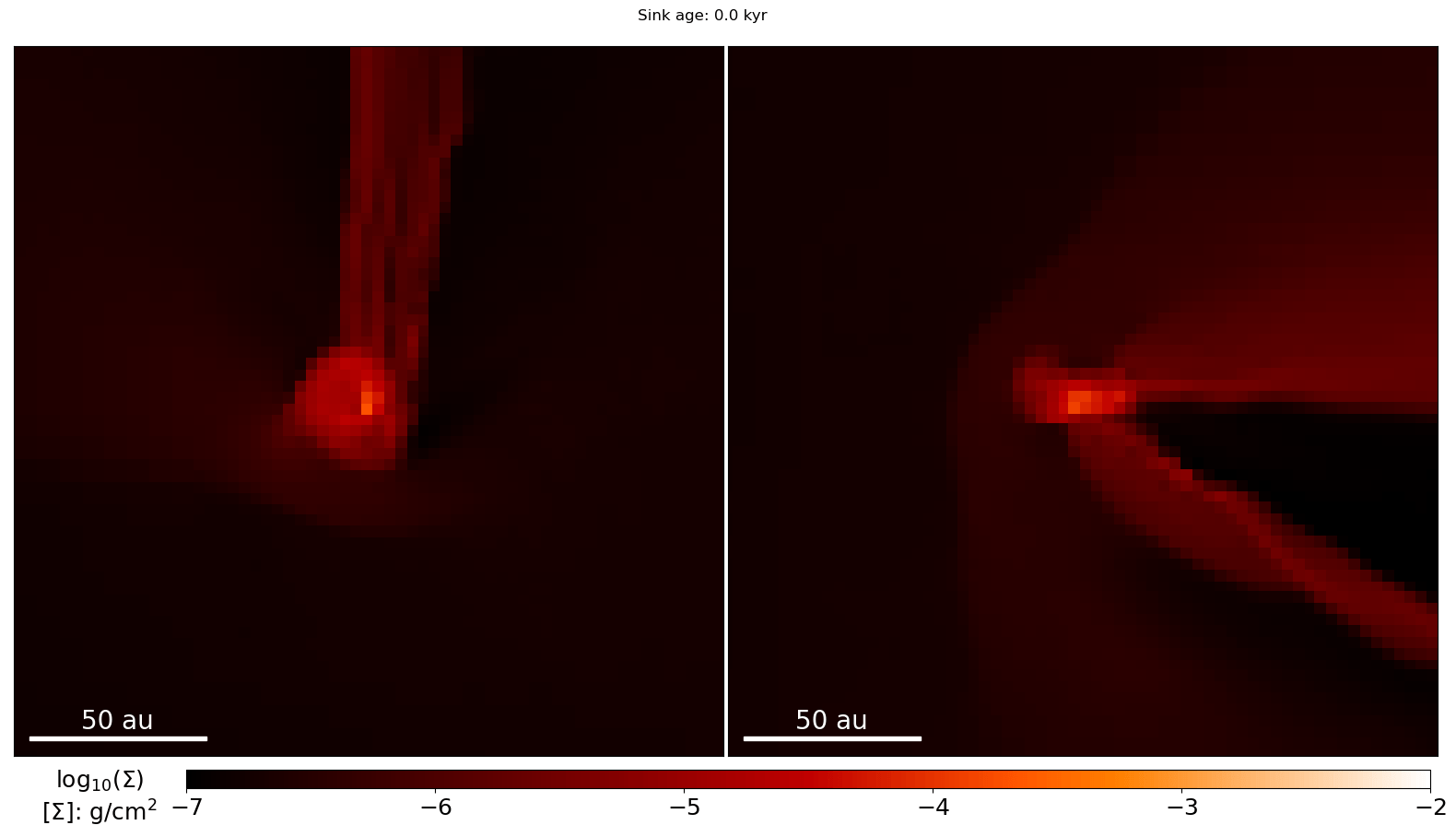

Küffmeier & Granzow Holm in prep
Trails of gas: signs of Bondi-Hoyle-Lyttleton accretion or photoevaporative wind?

Haworth et al. '25


Küffmeier & Granzow Holm in prep
Bondi-Hoyle(-Lyttleton) accretion (poster Ashtari-Jolehkaran; Padoan+ '24, Winter+ '24, Küffmeier '24)
for external photoevaporation see posters by Aru and Gkimisi
Sequence of star, disk & planet formation
Pineda et al. 2023
.
.
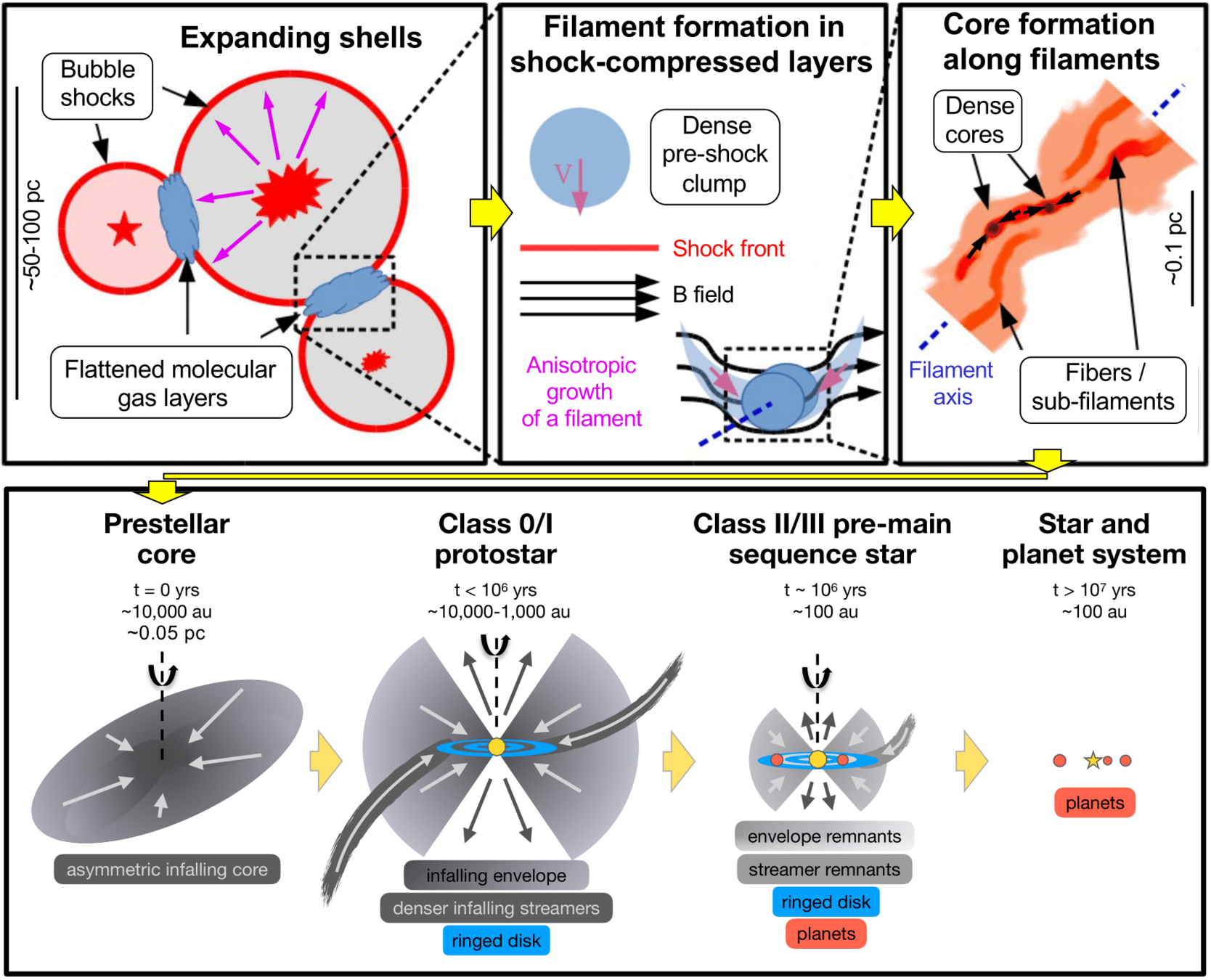
Star & disk are replenished by infall of initially unbound material
- Is the disk solely replenished with fresh material?
- Does infall frequently lead to the formation of a new misaligned outer disk (and if yes, for how long)? (see also Bate '18)
- Is (late) infall catastrophic? Does a completely new disk form?
Key questions to be addressed in the future
- Does infall trigger substructures that are precursors of planet formation?
(Bae+ '15, Lesur+ '15, Küffmeier+ '18, Kuznetsova + '22)
Implications for Al-26 heterogeneity
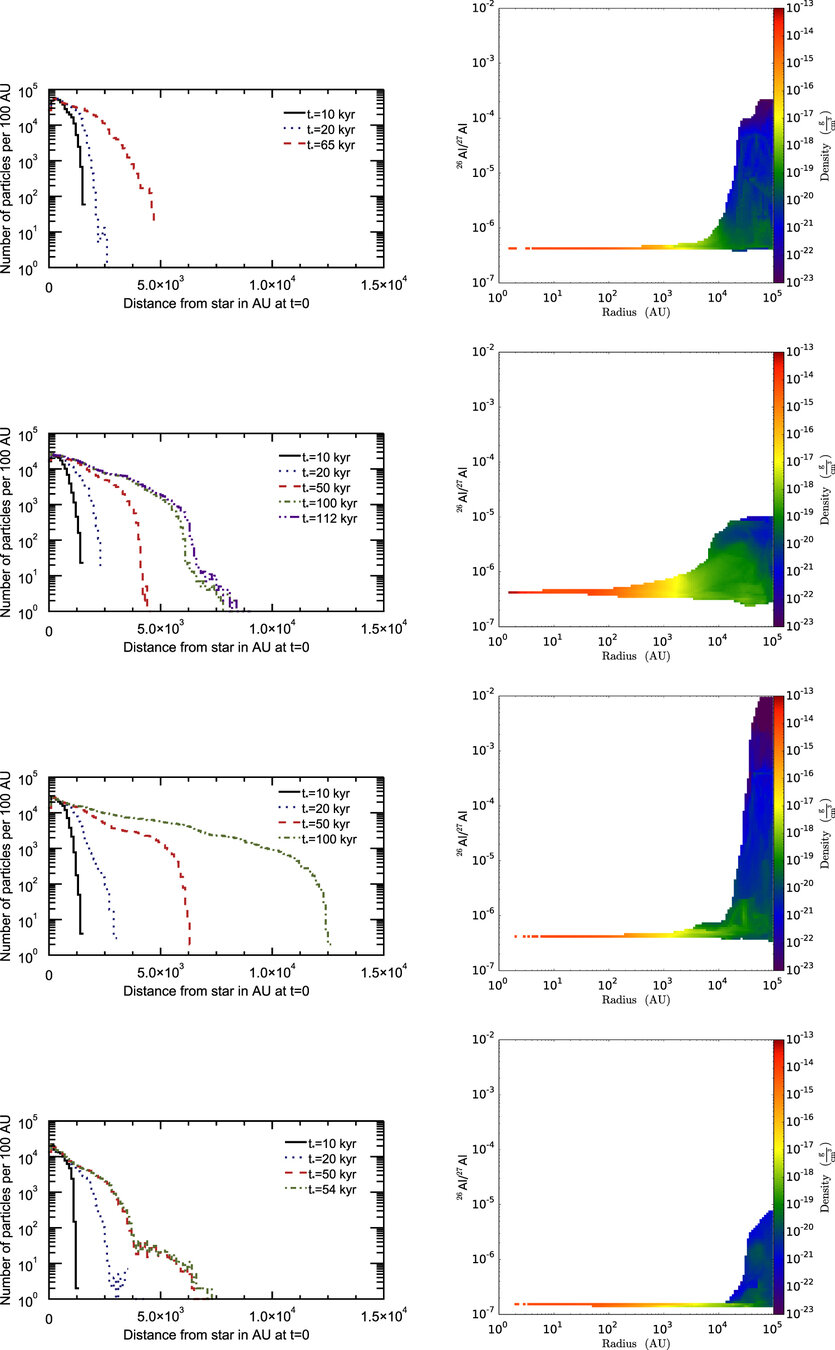
Küffmeier et al. 2016
- Gas is well-mixed within core, and hence Al-26 abundance is fixed during CAI formation (t<~100 kyr).
- BUT: significant deviations in Al-26 abundance beyond the core may likely be imprinted on disk afterwards!

Sequence of star, disk & planet formation
Pineda et al. 2023
.
.

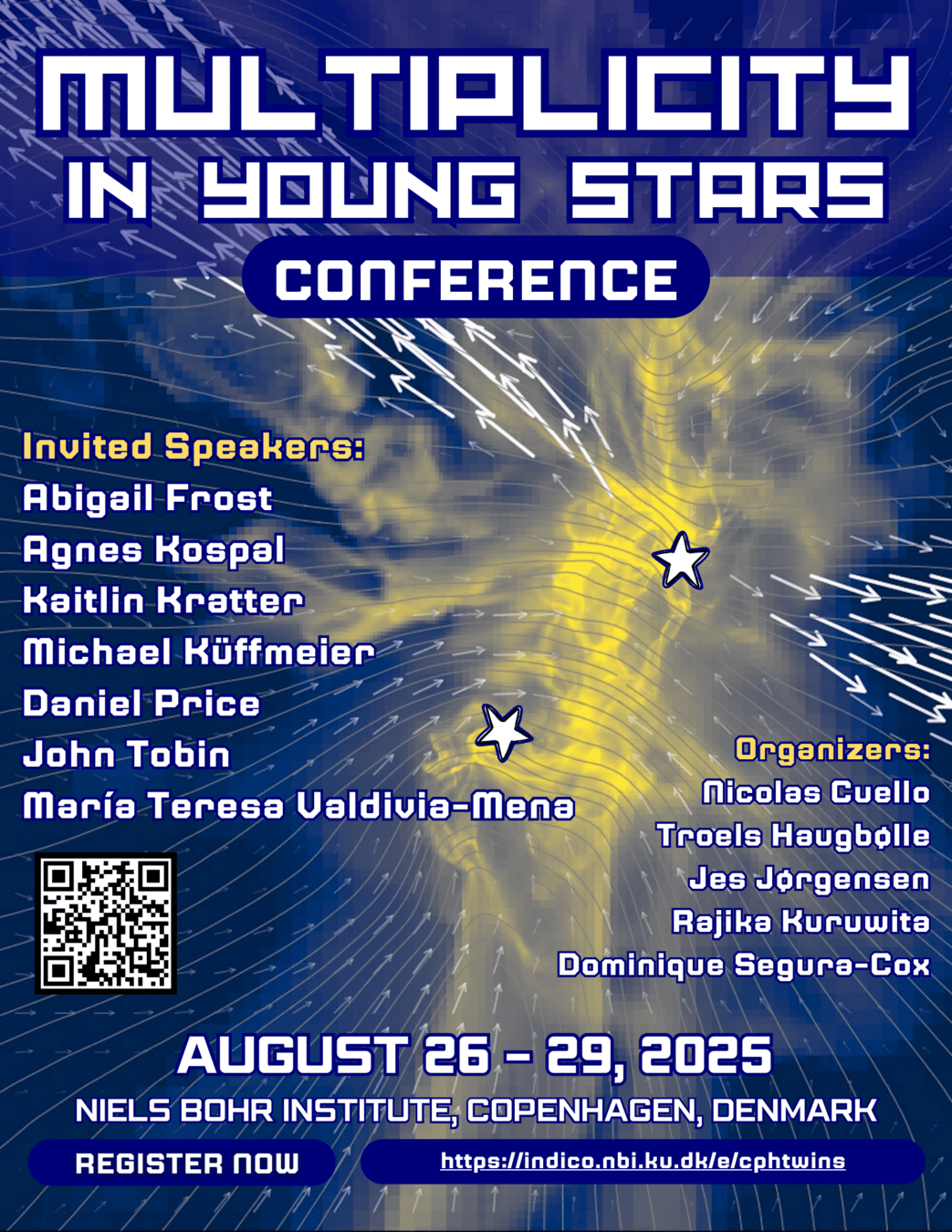
Summary
Disks are replenished, distorted or even destroyed by misaligned infall
Protostellar environment matters
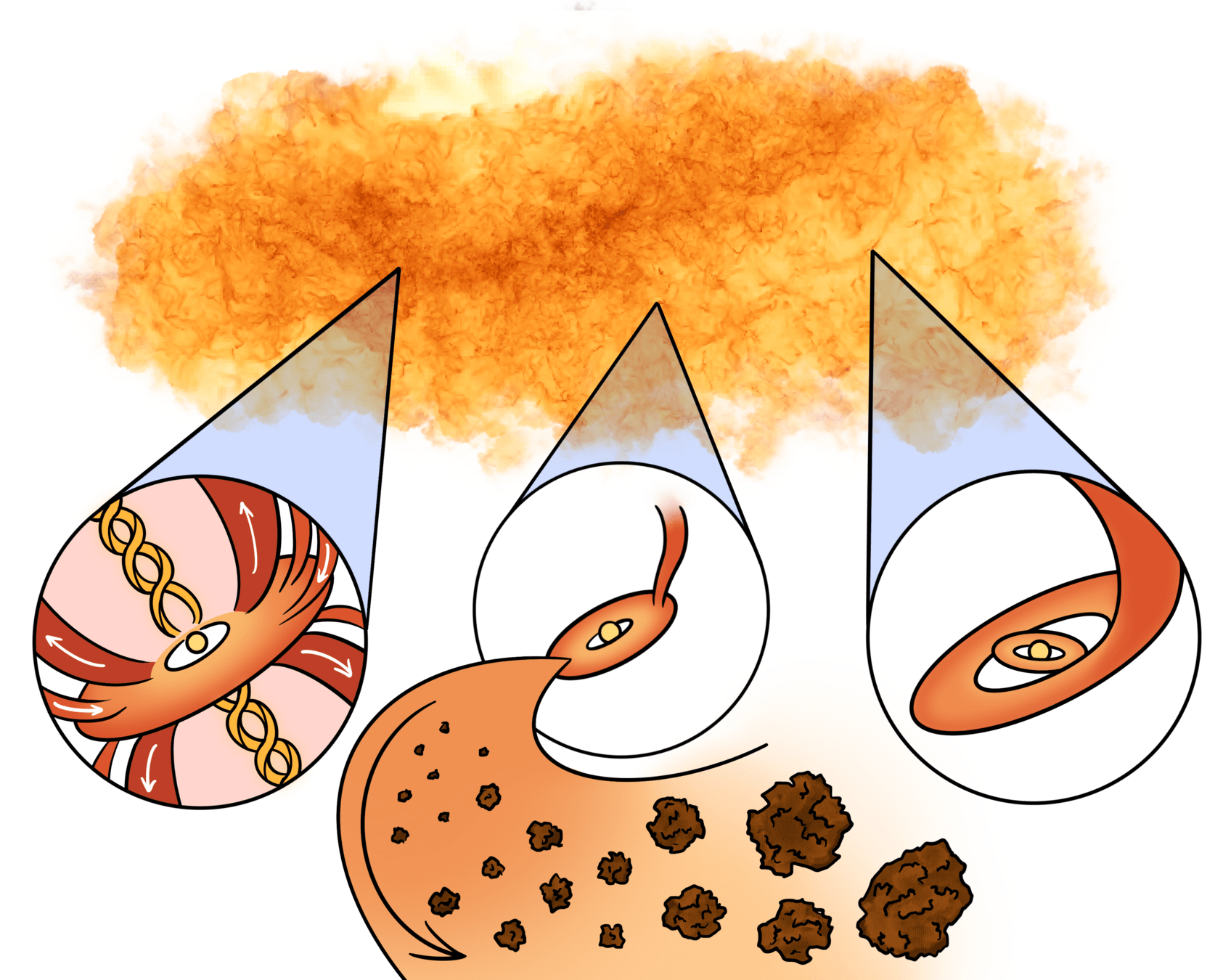
Star formation is a two-phase process consisting of mandatory initial collapse and post-collapse infall phase
Küffmeier 2024
Credit:
M. Lützen


EAS meeting Cork 2025, June 23-27